Comprehensive Report on Toyota's Management and Operational Strategies
VerifiedAdded on 2020/10/23
|18
|4933
|96
Report
AI Summary
This report provides a detailed analysis of Toyota's management and operations. It begins with an introduction to Toyota's structure, followed by a discussion of the roles of managers and leaders, highlighting the differences between them. The report explores various management and leadership theories, including their strengths and weaknesses, and examines their application in different situations such as conflict management and policy formation. It then delves into Toyota's key operations, the roles and responsibilities of managers in operational functions, and different operational approaches. The impact of external environmental factors on decision-making and the role of operational efficiencies in business success are also discussed. The report concludes with recommendations for future improvements, offering a comprehensive overview of Toyota's management and operational strategies. The report also explores the impact of managers and leaders on the organization, offering recommendations for future improvements.
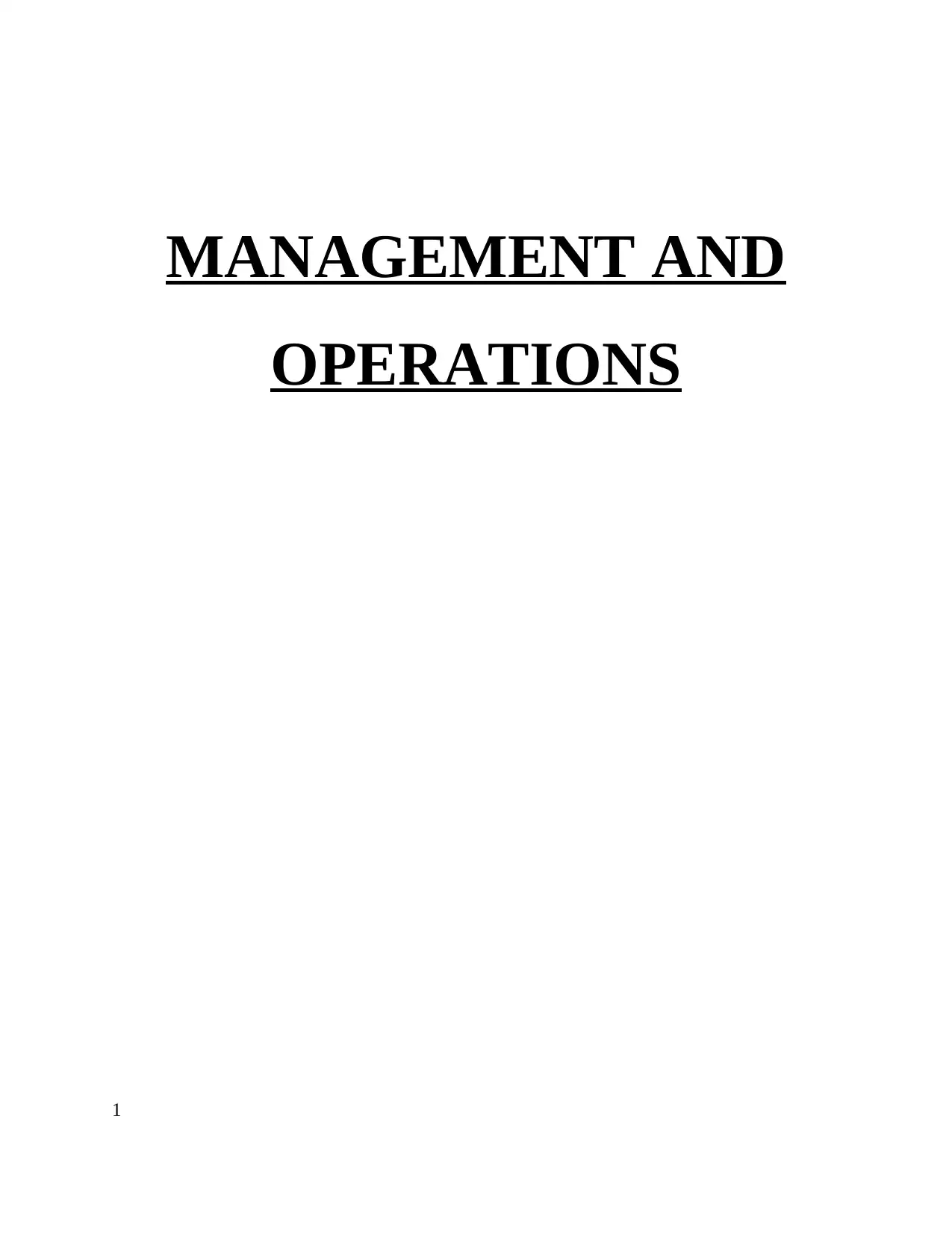
MANAGEMENT AND
OPERATIONS
1
OPERATIONS
1
Secure Best Marks with AI Grader
Need help grading? Try our AI Grader for instant feedback on your assignments.
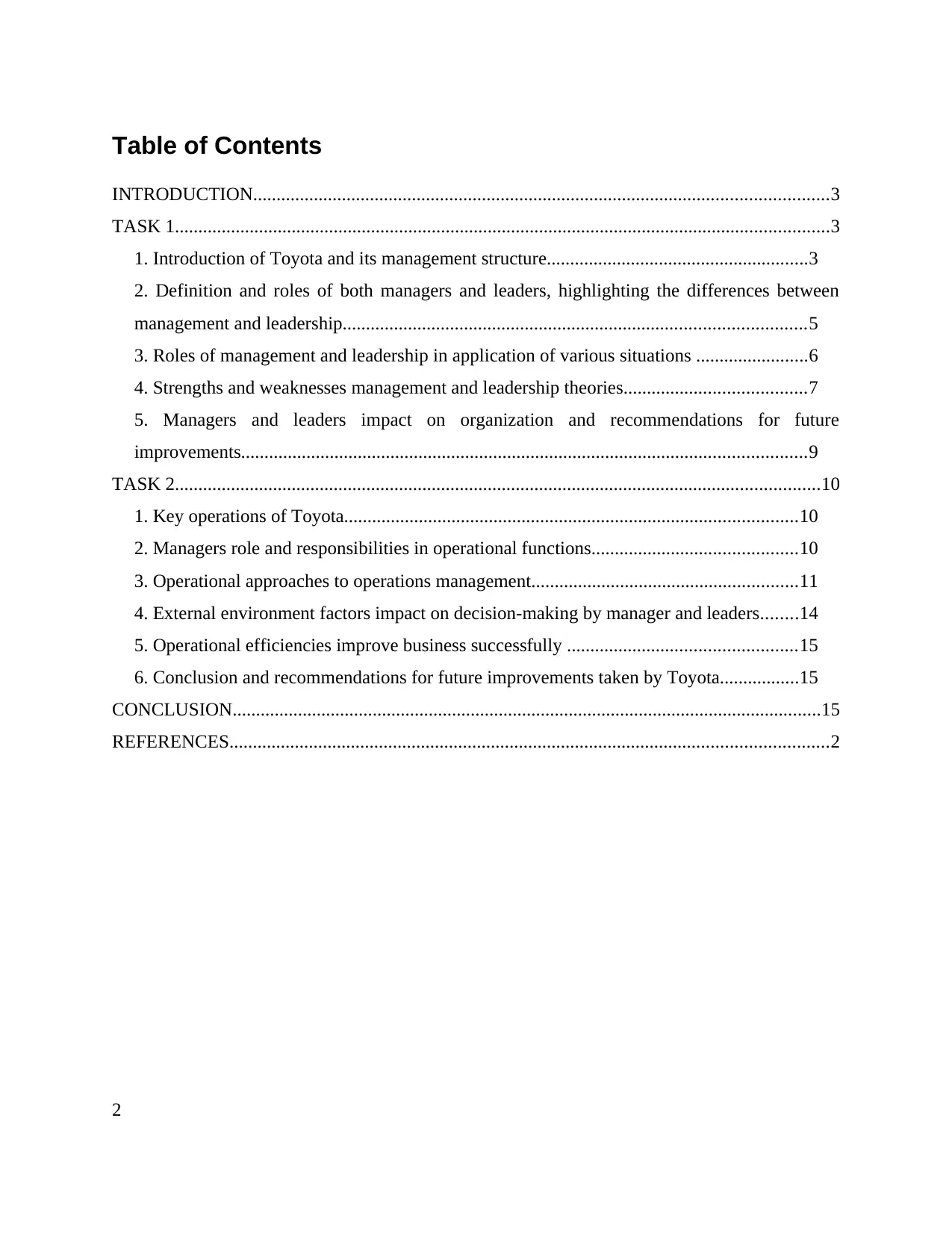
Table of Contents
INTRODUCTION...........................................................................................................................3
TASK 1............................................................................................................................................3
1. Introduction of Toyota and its management structure........................................................3
2. Definition and roles of both managers and leaders, highlighting the differences between
management and leadership...................................................................................................5
3. Roles of management and leadership in application of various situations ........................6
4. Strengths and weaknesses management and leadership theories.......................................7
5. Managers and leaders impact on organization and recommendations for future
improvements.........................................................................................................................9
TASK 2..........................................................................................................................................10
1. Key operations of Toyota.................................................................................................10
2. Managers role and responsibilities in operational functions............................................10
3. Operational approaches to operations management.........................................................11
4. External environment factors impact on decision-making by manager and leaders........14
5. Operational efficiencies improve business successfully .................................................15
6. Conclusion and recommendations for future improvements taken by Toyota.................15
CONCLUSION..............................................................................................................................15
REFERENCES................................................................................................................................2
2
INTRODUCTION...........................................................................................................................3
TASK 1............................................................................................................................................3
1. Introduction of Toyota and its management structure........................................................3
2. Definition and roles of both managers and leaders, highlighting the differences between
management and leadership...................................................................................................5
3. Roles of management and leadership in application of various situations ........................6
4. Strengths and weaknesses management and leadership theories.......................................7
5. Managers and leaders impact on organization and recommendations for future
improvements.........................................................................................................................9
TASK 2..........................................................................................................................................10
1. Key operations of Toyota.................................................................................................10
2. Managers role and responsibilities in operational functions............................................10
3. Operational approaches to operations management.........................................................11
4. External environment factors impact on decision-making by manager and leaders........14
5. Operational efficiencies improve business successfully .................................................15
6. Conclusion and recommendations for future improvements taken by Toyota.................15
CONCLUSION..............................................................................................................................15
REFERENCES................................................................................................................................2
2
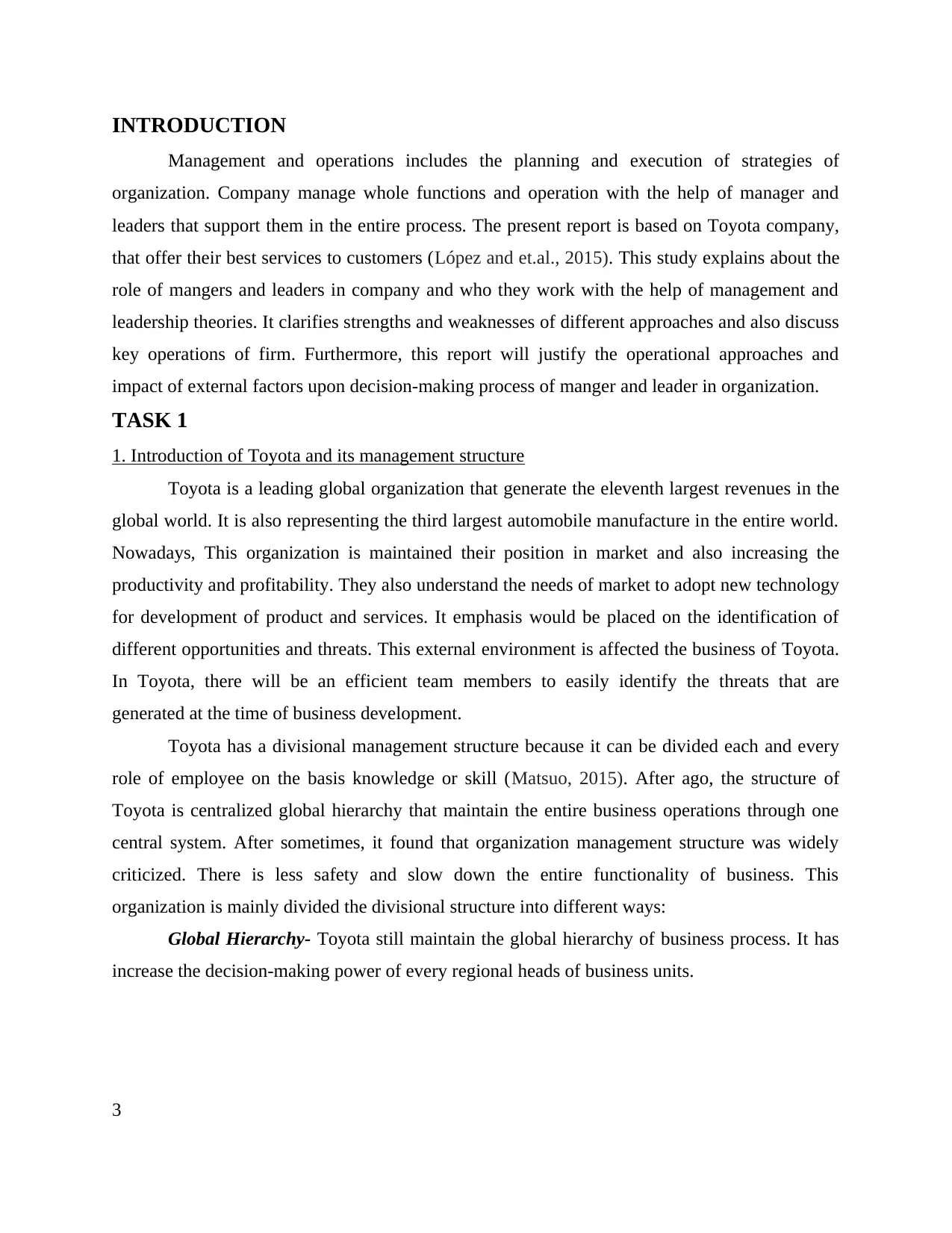
INTRODUCTION
Management and operations includes the planning and execution of strategies of
organization. Company manage whole functions and operation with the help of manager and
leaders that support them in the entire process. The present report is based on Toyota company,
that offer their best services to customers (López and et.al., 2015). This study explains about the
role of mangers and leaders in company and who they work with the help of management and
leadership theories. It clarifies strengths and weaknesses of different approaches and also discuss
key operations of firm. Furthermore, this report will justify the operational approaches and
impact of external factors upon decision-making process of manger and leader in organization.
TASK 1
1. Introduction of Toyota and its management structure
Toyota is a leading global organization that generate the eleventh largest revenues in the
global world. It is also representing the third largest automobile manufacture in the entire world.
Nowadays, This organization is maintained their position in market and also increasing the
productivity and profitability. They also understand the needs of market to adopt new technology
for development of product and services. It emphasis would be placed on the identification of
different opportunities and threats. This external environment is affected the business of Toyota.
In Toyota, there will be an efficient team members to easily identify the threats that are
generated at the time of business development.
Toyota has a divisional management structure because it can be divided each and every
role of employee on the basis knowledge or skill (Matsuo, 2015). After ago, the structure of
Toyota is centralized global hierarchy that maintain the entire business operations through one
central system. After sometimes, it found that organization management structure was widely
criticized. There is less safety and slow down the entire functionality of business. This
organization is mainly divided the divisional structure into different ways:
Global Hierarchy- Toyota still maintain the global hierarchy of business process. It has
increase the decision-making power of every regional heads of business units.
3
Management and operations includes the planning and execution of strategies of
organization. Company manage whole functions and operation with the help of manager and
leaders that support them in the entire process. The present report is based on Toyota company,
that offer their best services to customers (López and et.al., 2015). This study explains about the
role of mangers and leaders in company and who they work with the help of management and
leadership theories. It clarifies strengths and weaknesses of different approaches and also discuss
key operations of firm. Furthermore, this report will justify the operational approaches and
impact of external factors upon decision-making process of manger and leader in organization.
TASK 1
1. Introduction of Toyota and its management structure
Toyota is a leading global organization that generate the eleventh largest revenues in the
global world. It is also representing the third largest automobile manufacture in the entire world.
Nowadays, This organization is maintained their position in market and also increasing the
productivity and profitability. They also understand the needs of market to adopt new technology
for development of product and services. It emphasis would be placed on the identification of
different opportunities and threats. This external environment is affected the business of Toyota.
In Toyota, there will be an efficient team members to easily identify the threats that are
generated at the time of business development.
Toyota has a divisional management structure because it can be divided each and every
role of employee on the basis knowledge or skill (Matsuo, 2015). After ago, the structure of
Toyota is centralized global hierarchy that maintain the entire business operations through one
central system. After sometimes, it found that organization management structure was widely
criticized. There is less safety and slow down the entire functionality of business. This
organization is mainly divided the divisional structure into different ways:
Global Hierarchy- Toyota still maintain the global hierarchy of business process. It has
increase the decision-making power of every regional heads of business units.
3
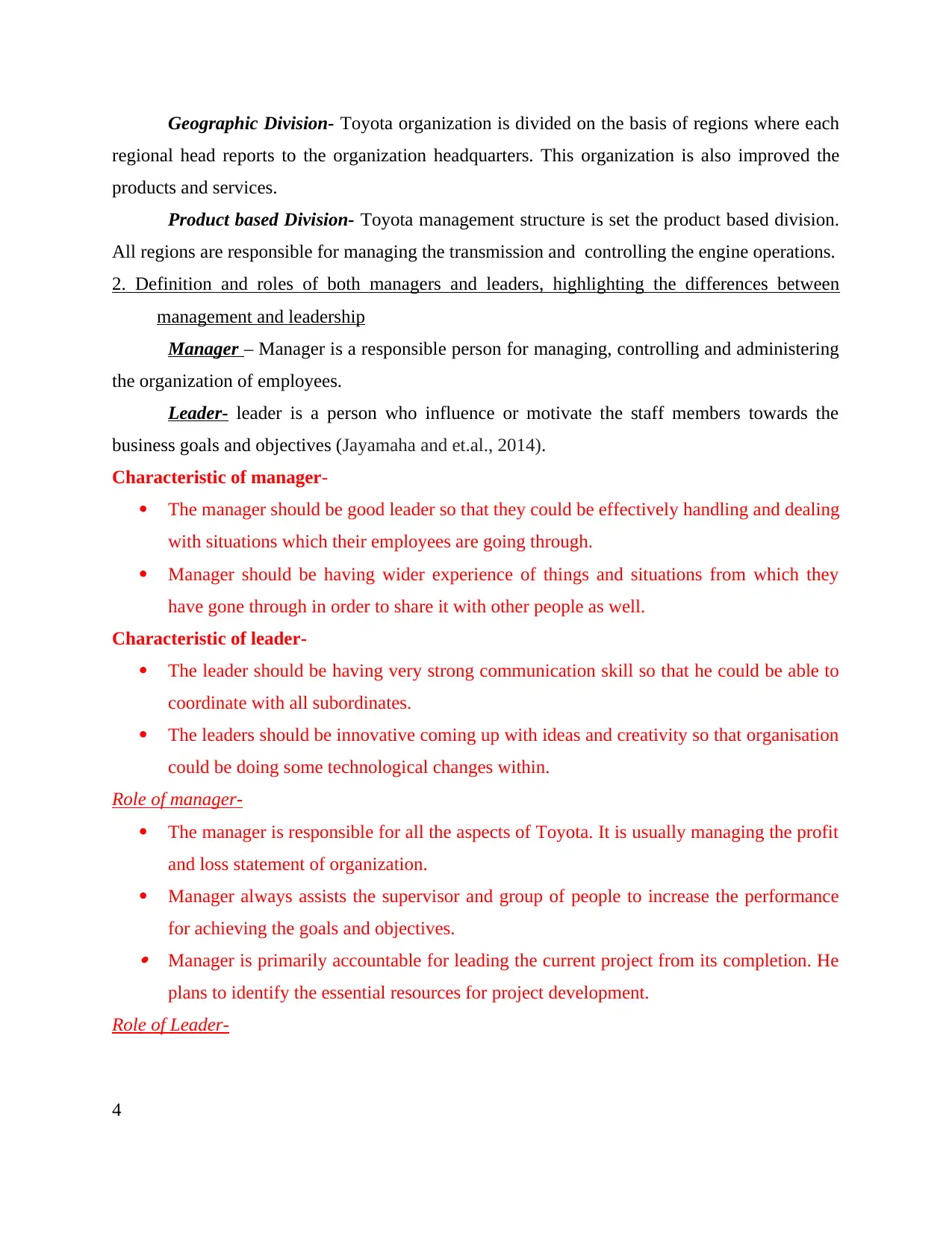
Geographic Division- Toyota organization is divided on the basis of regions where each
regional head reports to the organization headquarters. This organization is also improved the
products and services.
Product based Division- Toyota management structure is set the product based division.
All regions are responsible for managing the transmission and controlling the engine operations.
2. Definition and roles of both managers and leaders, highlighting the differences between
management and leadership
Manager – Manager is a responsible person for managing, controlling and administering
the organization of employees.
Leader- leader is a person who influence or motivate the staff members towards the
business goals and objectives (Jayamaha and et.al., 2014).
Characteristic of manager-
The manager should be good leader so that they could be effectively handling and dealing
with situations which their employees are going through.
Manager should be having wider experience of things and situations from which they
have gone through in order to share it with other people as well.
Characteristic of leader-
The leader should be having very strong communication skill so that he could be able to
coordinate with all subordinates.
The leaders should be innovative coming up with ideas and creativity so that organisation
could be doing some technological changes within.
Role of manager-
The manager is responsible for all the aspects of Toyota. It is usually managing the profit
and loss statement of organization.
Manager always assists the supervisor and group of people to increase the performance
for achieving the goals and objectives. Manager is primarily accountable for leading the current project from its completion. He
plans to identify the essential resources for project development.
Role of Leader-
4
regional head reports to the organization headquarters. This organization is also improved the
products and services.
Product based Division- Toyota management structure is set the product based division.
All regions are responsible for managing the transmission and controlling the engine operations.
2. Definition and roles of both managers and leaders, highlighting the differences between
management and leadership
Manager – Manager is a responsible person for managing, controlling and administering
the organization of employees.
Leader- leader is a person who influence or motivate the staff members towards the
business goals and objectives (Jayamaha and et.al., 2014).
Characteristic of manager-
The manager should be good leader so that they could be effectively handling and dealing
with situations which their employees are going through.
Manager should be having wider experience of things and situations from which they
have gone through in order to share it with other people as well.
Characteristic of leader-
The leader should be having very strong communication skill so that he could be able to
coordinate with all subordinates.
The leaders should be innovative coming up with ideas and creativity so that organisation
could be doing some technological changes within.
Role of manager-
The manager is responsible for all the aspects of Toyota. It is usually managing the profit
and loss statement of organization.
Manager always assists the supervisor and group of people to increase the performance
for achieving the goals and objectives. Manager is primarily accountable for leading the current project from its completion. He
plans to identify the essential resources for project development.
Role of Leader-
4
Secure Best Marks with AI Grader
Need help grading? Try our AI Grader for instant feedback on your assignments.
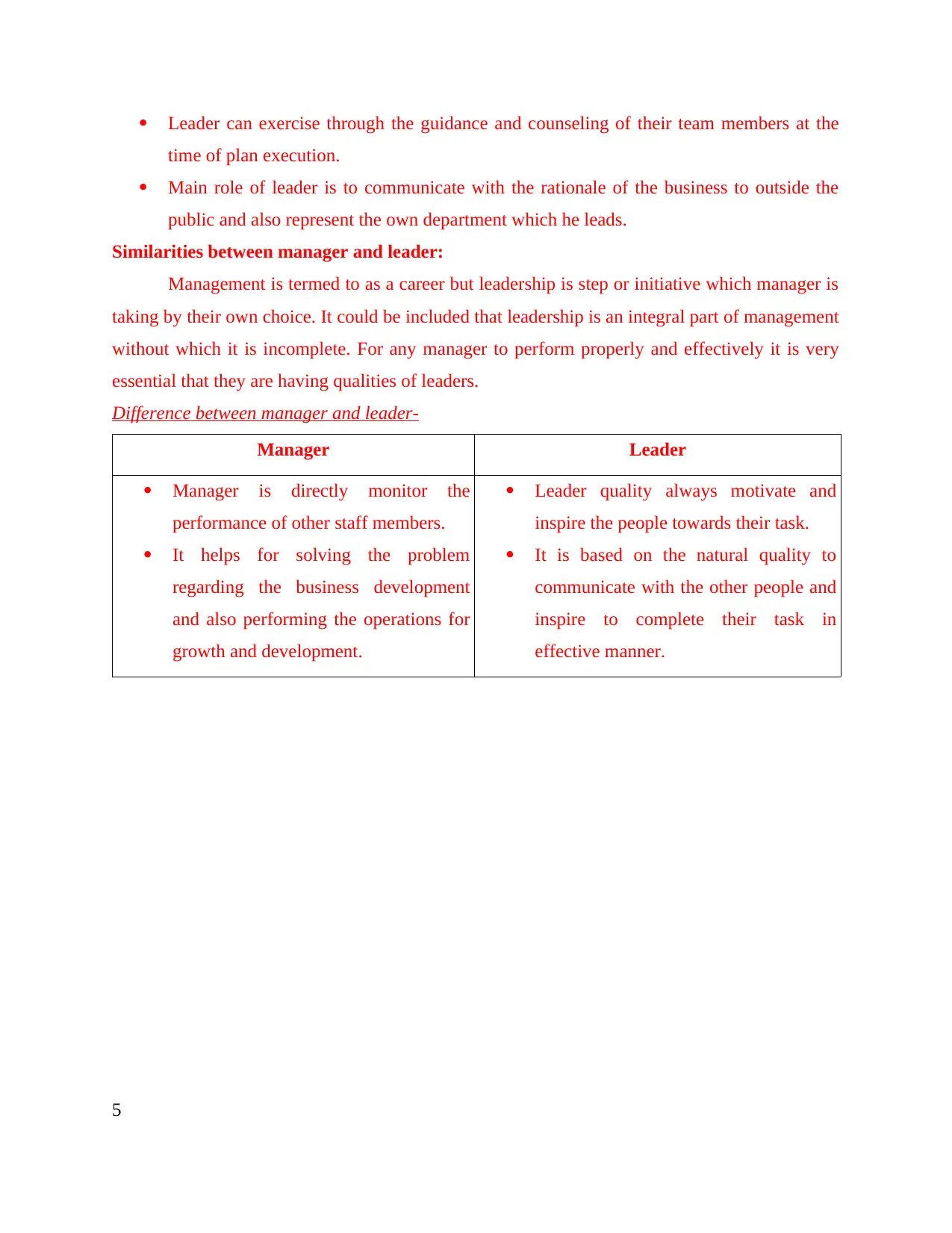
Leader can exercise through the guidance and counseling of their team members at the
time of plan execution.
Main role of leader is to communicate with the rationale of the business to outside the
public and also represent the own department which he leads.
Similarities between manager and leader:
Management is termed to as a career but leadership is step or initiative which manager is
taking by their own choice. It could be included that leadership is an integral part of management
without which it is incomplete. For any manager to perform properly and effectively it is very
essential that they are having qualities of leaders.
Difference between manager and leader-
Manager Leader
Manager is directly monitor the
performance of other staff members.
It helps for solving the problem
regarding the business development
and also performing the operations for
growth and development.
Leader quality always motivate and
inspire the people towards their task.
It is based on the natural quality to
communicate with the other people and
inspire to complete their task in
effective manner.
5
time of plan execution.
Main role of leader is to communicate with the rationale of the business to outside the
public and also represent the own department which he leads.
Similarities between manager and leader:
Management is termed to as a career but leadership is step or initiative which manager is
taking by their own choice. It could be included that leadership is an integral part of management
without which it is incomplete. For any manager to perform properly and effectively it is very
essential that they are having qualities of leaders.
Difference between manager and leader-
Manager Leader
Manager is directly monitor the
performance of other staff members.
It helps for solving the problem
regarding the business development
and also performing the operations for
growth and development.
Leader quality always motivate and
inspire the people towards their task.
It is based on the natural quality to
communicate with the other people and
inspire to complete their task in
effective manner.
5
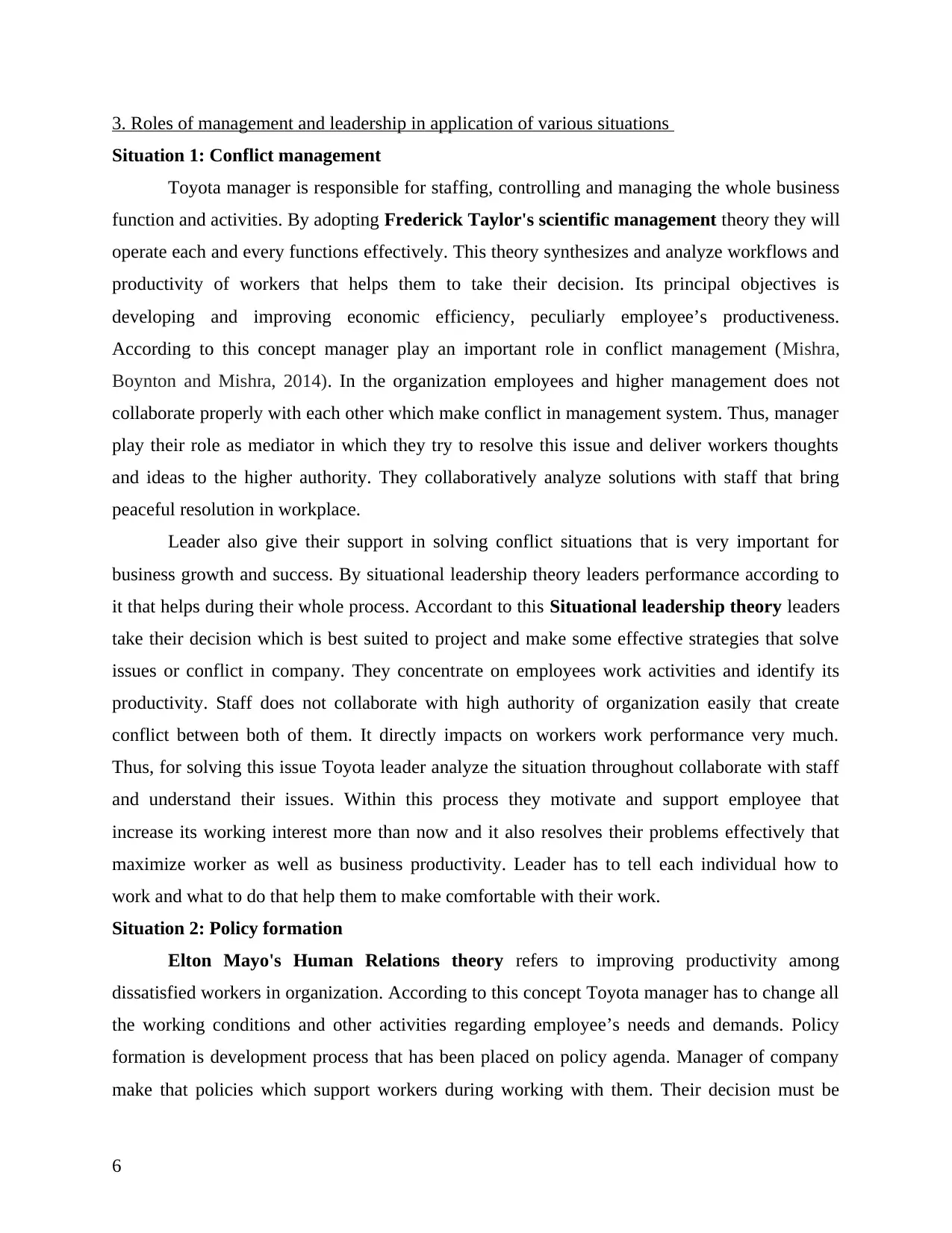
3. Roles of management and leadership in application of various situations
Situation 1: Conflict management
Toyota manager is responsible for staffing, controlling and managing the whole business
function and activities. By adopting Frederick Taylor's scientific management theory they will
operate each and every functions effectively. This theory synthesizes and analyze workflows and
productivity of workers that helps them to take their decision. Its principal objectives is
developing and improving economic efficiency, peculiarly employee’s productiveness.
According to this concept manager play an important role in conflict management (Mishra,
Boynton and Mishra, 2014). In the organization employees and higher management does not
collaborate properly with each other which make conflict in management system. Thus, manager
play their role as mediator in which they try to resolve this issue and deliver workers thoughts
and ideas to the higher authority. They collaboratively analyze solutions with staff that bring
peaceful resolution in workplace.
Leader also give their support in solving conflict situations that is very important for
business growth and success. By situational leadership theory leaders performance according to
it that helps during their whole process. Accordant to this Situational leadership theory leaders
take their decision which is best suited to project and make some effective strategies that solve
issues or conflict in company. They concentrate on employees work activities and identify its
productivity. Staff does not collaborate with high authority of organization easily that create
conflict between both of them. It directly impacts on workers work performance very much.
Thus, for solving this issue Toyota leader analyze the situation throughout collaborate with staff
and understand their issues. Within this process they motivate and support employee that
increase its working interest more than now and it also resolves their problems effectively that
maximize worker as well as business productivity. Leader has to tell each individual how to
work and what to do that help them to make comfortable with their work.
Situation 2: Policy formation
Elton Mayo's Human Relations theory refers to improving productivity among
dissatisfied workers in organization. According to this concept Toyota manager has to change all
the working conditions and other activities regarding employee’s needs and demands. Policy
formation is development process that has been placed on policy agenda. Manager of company
make that policies which support workers during working with them. Their decision must be
6
Situation 1: Conflict management
Toyota manager is responsible for staffing, controlling and managing the whole business
function and activities. By adopting Frederick Taylor's scientific management theory they will
operate each and every functions effectively. This theory synthesizes and analyze workflows and
productivity of workers that helps them to take their decision. Its principal objectives is
developing and improving economic efficiency, peculiarly employee’s productiveness.
According to this concept manager play an important role in conflict management (Mishra,
Boynton and Mishra, 2014). In the organization employees and higher management does not
collaborate properly with each other which make conflict in management system. Thus, manager
play their role as mediator in which they try to resolve this issue and deliver workers thoughts
and ideas to the higher authority. They collaboratively analyze solutions with staff that bring
peaceful resolution in workplace.
Leader also give their support in solving conflict situations that is very important for
business growth and success. By situational leadership theory leaders performance according to
it that helps during their whole process. Accordant to this Situational leadership theory leaders
take their decision which is best suited to project and make some effective strategies that solve
issues or conflict in company. They concentrate on employees work activities and identify its
productivity. Staff does not collaborate with high authority of organization easily that create
conflict between both of them. It directly impacts on workers work performance very much.
Thus, for solving this issue Toyota leader analyze the situation throughout collaborate with staff
and understand their issues. Within this process they motivate and support employee that
increase its working interest more than now and it also resolves their problems effectively that
maximize worker as well as business productivity. Leader has to tell each individual how to
work and what to do that help them to make comfortable with their work.
Situation 2: Policy formation
Elton Mayo's Human Relations theory refers to improving productivity among
dissatisfied workers in organization. According to this concept Toyota manager has to change all
the working conditions and other activities regarding employee’s needs and demands. Policy
formation is development process that has been placed on policy agenda. Manager of company
make that policies which support workers during working with them. Their decision must be
6
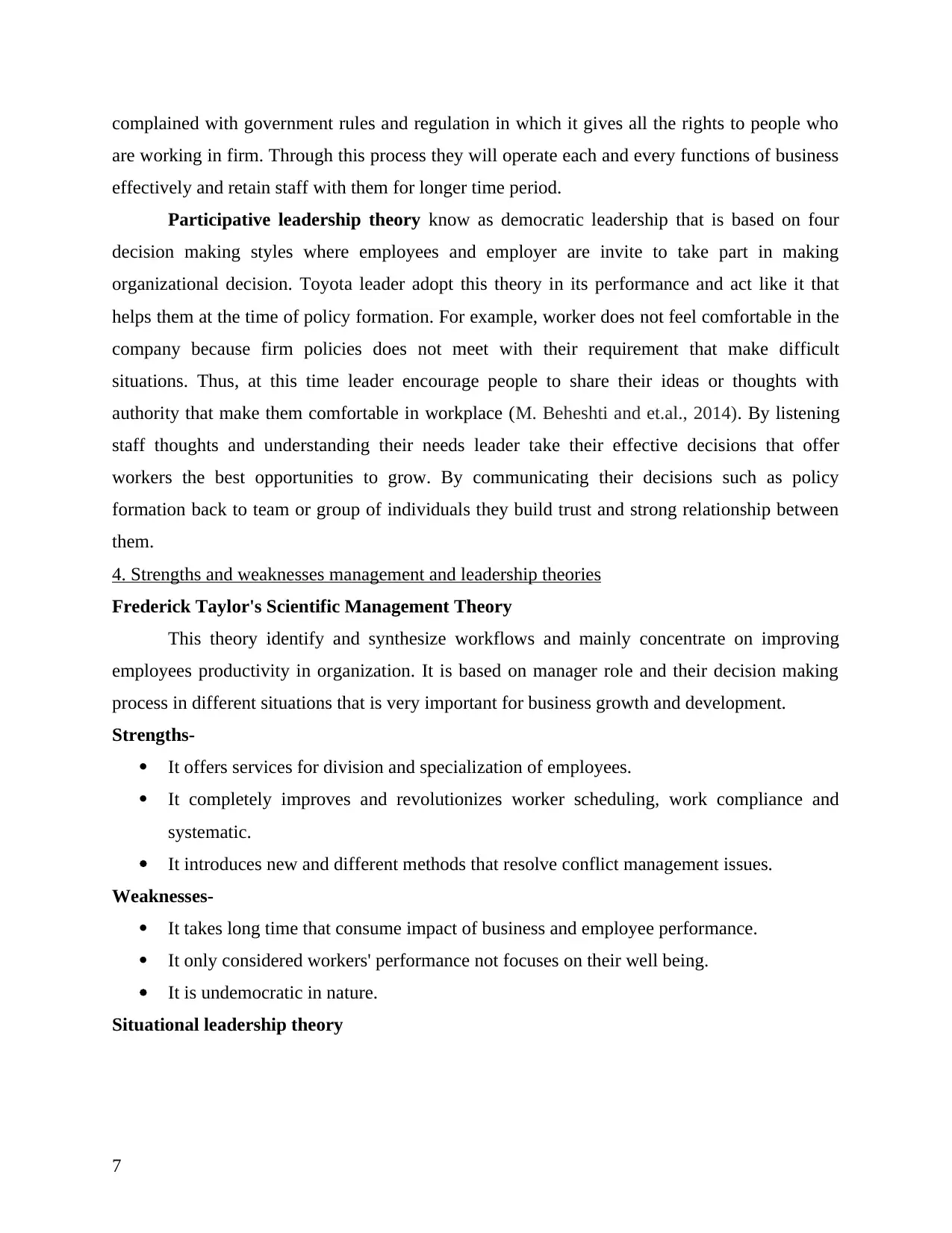
complained with government rules and regulation in which it gives all the rights to people who
are working in firm. Through this process they will operate each and every functions of business
effectively and retain staff with them for longer time period.
Participative leadership theory know as democratic leadership that is based on four
decision making styles where employees and employer are invite to take part in making
organizational decision. Toyota leader adopt this theory in its performance and act like it that
helps them at the time of policy formation. For example, worker does not feel comfortable in the
company because firm policies does not meet with their requirement that make difficult
situations. Thus, at this time leader encourage people to share their ideas or thoughts with
authority that make them comfortable in workplace (M. Beheshti and et.al., 2014). By listening
staff thoughts and understanding their needs leader take their effective decisions that offer
workers the best opportunities to grow. By communicating their decisions such as policy
formation back to team or group of individuals they build trust and strong relationship between
them.
4. Strengths and weaknesses management and leadership theories
Frederick Taylor's Scientific Management Theory
This theory identify and synthesize workflows and mainly concentrate on improving
employees productivity in organization. It is based on manager role and their decision making
process in different situations that is very important for business growth and development.
Strengths-
It offers services for division and specialization of employees.
It completely improves and revolutionizes worker scheduling, work compliance and
systematic.
It introduces new and different methods that resolve conflict management issues.
Weaknesses-
It takes long time that consume impact of business and employee performance.
It only considered workers' performance not focuses on their well being.
It is undemocratic in nature.
Situational leadership theory
7
are working in firm. Through this process they will operate each and every functions of business
effectively and retain staff with them for longer time period.
Participative leadership theory know as democratic leadership that is based on four
decision making styles where employees and employer are invite to take part in making
organizational decision. Toyota leader adopt this theory in its performance and act like it that
helps them at the time of policy formation. For example, worker does not feel comfortable in the
company because firm policies does not meet with their requirement that make difficult
situations. Thus, at this time leader encourage people to share their ideas or thoughts with
authority that make them comfortable in workplace (M. Beheshti and et.al., 2014). By listening
staff thoughts and understanding their needs leader take their effective decisions that offer
workers the best opportunities to grow. By communicating their decisions such as policy
formation back to team or group of individuals they build trust and strong relationship between
them.
4. Strengths and weaknesses management and leadership theories
Frederick Taylor's Scientific Management Theory
This theory identify and synthesize workflows and mainly concentrate on improving
employees productivity in organization. It is based on manager role and their decision making
process in different situations that is very important for business growth and development.
Strengths-
It offers services for division and specialization of employees.
It completely improves and revolutionizes worker scheduling, work compliance and
systematic.
It introduces new and different methods that resolve conflict management issues.
Weaknesses-
It takes long time that consume impact of business and employee performance.
It only considered workers' performance not focuses on their well being.
It is undemocratic in nature.
Situational leadership theory
7
Paraphrase This Document
Need a fresh take? Get an instant paraphrase of this document with our AI Paraphraser
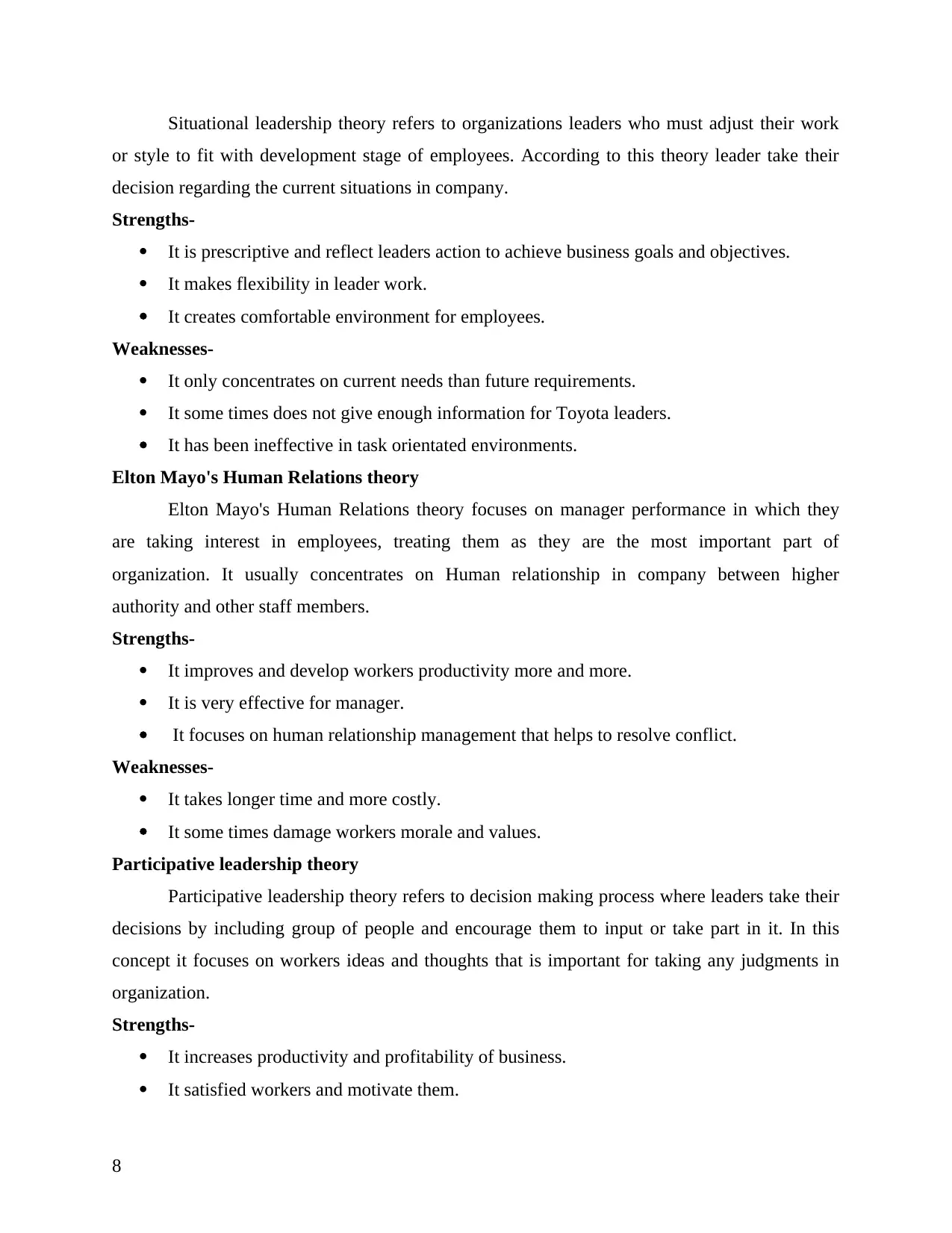
Situational leadership theory refers to organizations leaders who must adjust their work
or style to fit with development stage of employees. According to this theory leader take their
decision regarding the current situations in company.
Strengths-
It is prescriptive and reflect leaders action to achieve business goals and objectives.
It makes flexibility in leader work.
It creates comfortable environment for employees.
Weaknesses-
It only concentrates on current needs than future requirements.
It some times does not give enough information for Toyota leaders.
It has been ineffective in task orientated environments.
Elton Mayo's Human Relations theory
Elton Mayo's Human Relations theory focuses on manager performance in which they
are taking interest in employees, treating them as they are the most important part of
organization. It usually concentrates on Human relationship in company between higher
authority and other staff members.
Strengths-
It improves and develop workers productivity more and more.
It is very effective for manager.
It focuses on human relationship management that helps to resolve conflict.
Weaknesses-
It takes longer time and more costly.
It some times damage workers morale and values.
Participative leadership theory
Participative leadership theory refers to decision making process where leaders take their
decisions by including group of people and encourage them to input or take part in it. In this
concept it focuses on workers ideas and thoughts that is important for taking any judgments in
organization.
Strengths-
It increases productivity and profitability of business.
It satisfied workers and motivate them.
8
or style to fit with development stage of employees. According to this theory leader take their
decision regarding the current situations in company.
Strengths-
It is prescriptive and reflect leaders action to achieve business goals and objectives.
It makes flexibility in leader work.
It creates comfortable environment for employees.
Weaknesses-
It only concentrates on current needs than future requirements.
It some times does not give enough information for Toyota leaders.
It has been ineffective in task orientated environments.
Elton Mayo's Human Relations theory
Elton Mayo's Human Relations theory focuses on manager performance in which they
are taking interest in employees, treating them as they are the most important part of
organization. It usually concentrates on Human relationship in company between higher
authority and other staff members.
Strengths-
It improves and develop workers productivity more and more.
It is very effective for manager.
It focuses on human relationship management that helps to resolve conflict.
Weaknesses-
It takes longer time and more costly.
It some times damage workers morale and values.
Participative leadership theory
Participative leadership theory refers to decision making process where leaders take their
decisions by including group of people and encourage them to input or take part in it. In this
concept it focuses on workers ideas and thoughts that is important for taking any judgments in
organization.
Strengths-
It increases productivity and profitability of business.
It satisfied workers and motivate them.
8
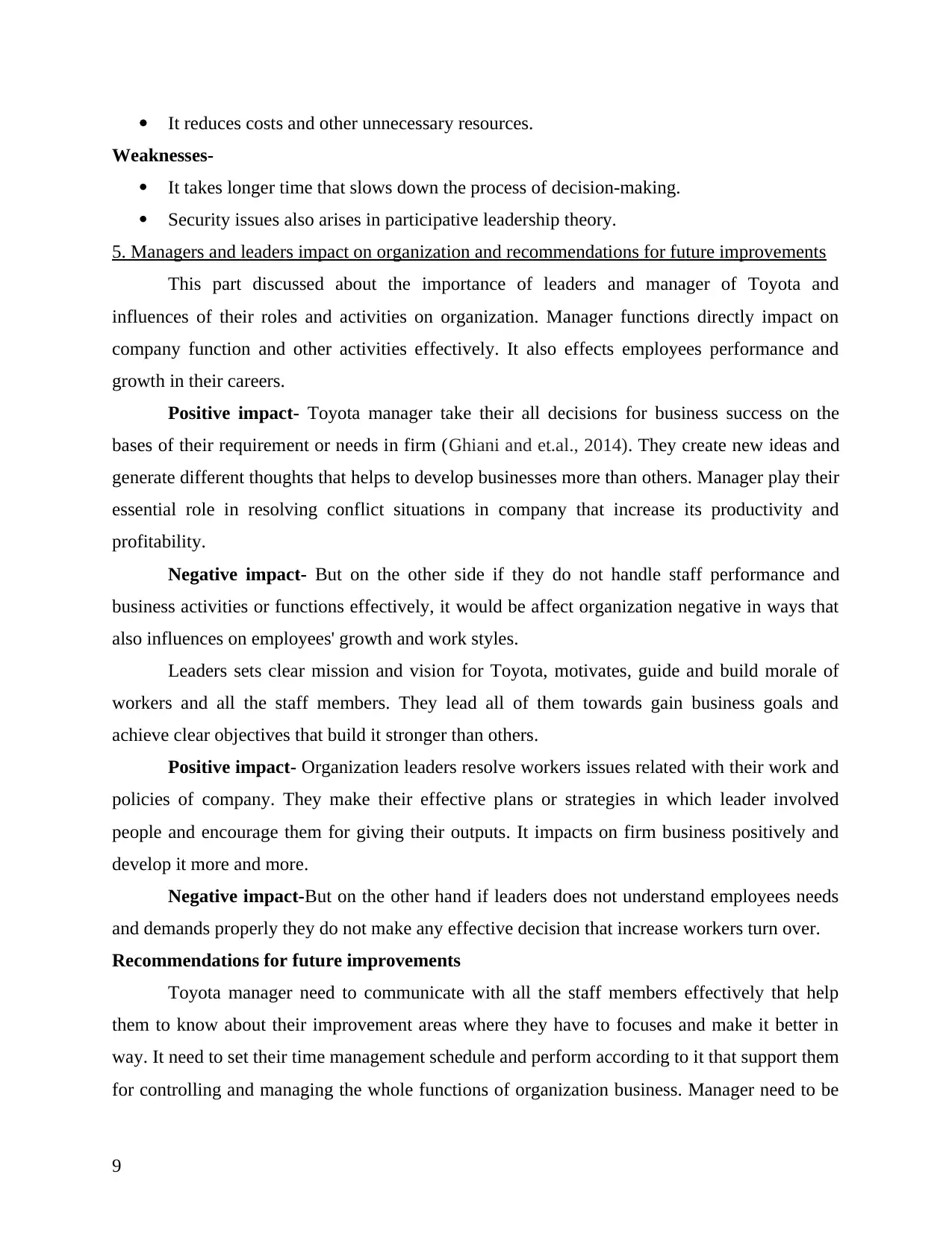
It reduces costs and other unnecessary resources.
Weaknesses-
It takes longer time that slows down the process of decision-making.
Security issues also arises in participative leadership theory.
5. Managers and leaders impact on organization and recommendations for future improvements
This part discussed about the importance of leaders and manager of Toyota and
influences of their roles and activities on organization. Manager functions directly impact on
company function and other activities effectively. It also effects employees performance and
growth in their careers.
Positive impact- Toyota manager take their all decisions for business success on the
bases of their requirement or needs in firm (Ghiani and et.al., 2014). They create new ideas and
generate different thoughts that helps to develop businesses more than others. Manager play their
essential role in resolving conflict situations in company that increase its productivity and
profitability.
Negative impact- But on the other side if they do not handle staff performance and
business activities or functions effectively, it would be affect organization negative in ways that
also influences on employees' growth and work styles.
Leaders sets clear mission and vision for Toyota, motivates, guide and build morale of
workers and all the staff members. They lead all of them towards gain business goals and
achieve clear objectives that build it stronger than others.
Positive impact- Organization leaders resolve workers issues related with their work and
policies of company. They make their effective plans or strategies in which leader involved
people and encourage them for giving their outputs. It impacts on firm business positively and
develop it more and more.
Negative impact-But on the other hand if leaders does not understand employees needs
and demands properly they do not make any effective decision that increase workers turn over.
Recommendations for future improvements
Toyota manager need to communicate with all the staff members effectively that help
them to know about their improvement areas where they have to focuses and make it better in
way. It need to set their time management schedule and perform according to it that support them
for controlling and managing the whole functions of organization business. Manager need to be
9
Weaknesses-
It takes longer time that slows down the process of decision-making.
Security issues also arises in participative leadership theory.
5. Managers and leaders impact on organization and recommendations for future improvements
This part discussed about the importance of leaders and manager of Toyota and
influences of their roles and activities on organization. Manager functions directly impact on
company function and other activities effectively. It also effects employees performance and
growth in their careers.
Positive impact- Toyota manager take their all decisions for business success on the
bases of their requirement or needs in firm (Ghiani and et.al., 2014). They create new ideas and
generate different thoughts that helps to develop businesses more than others. Manager play their
essential role in resolving conflict situations in company that increase its productivity and
profitability.
Negative impact- But on the other side if they do not handle staff performance and
business activities or functions effectively, it would be affect organization negative in ways that
also influences on employees' growth and work styles.
Leaders sets clear mission and vision for Toyota, motivates, guide and build morale of
workers and all the staff members. They lead all of them towards gain business goals and
achieve clear objectives that build it stronger than others.
Positive impact- Organization leaders resolve workers issues related with their work and
policies of company. They make their effective plans or strategies in which leader involved
people and encourage them for giving their outputs. It impacts on firm business positively and
develop it more and more.
Negative impact-But on the other hand if leaders does not understand employees needs
and demands properly they do not make any effective decision that increase workers turn over.
Recommendations for future improvements
Toyota manager need to communicate with all the staff members effectively that help
them to know about their improvement areas where they have to focuses and make it better in
way. It need to set their time management schedule and perform according to it that support them
for controlling and managing the whole functions of organization business. Manager need to be
9
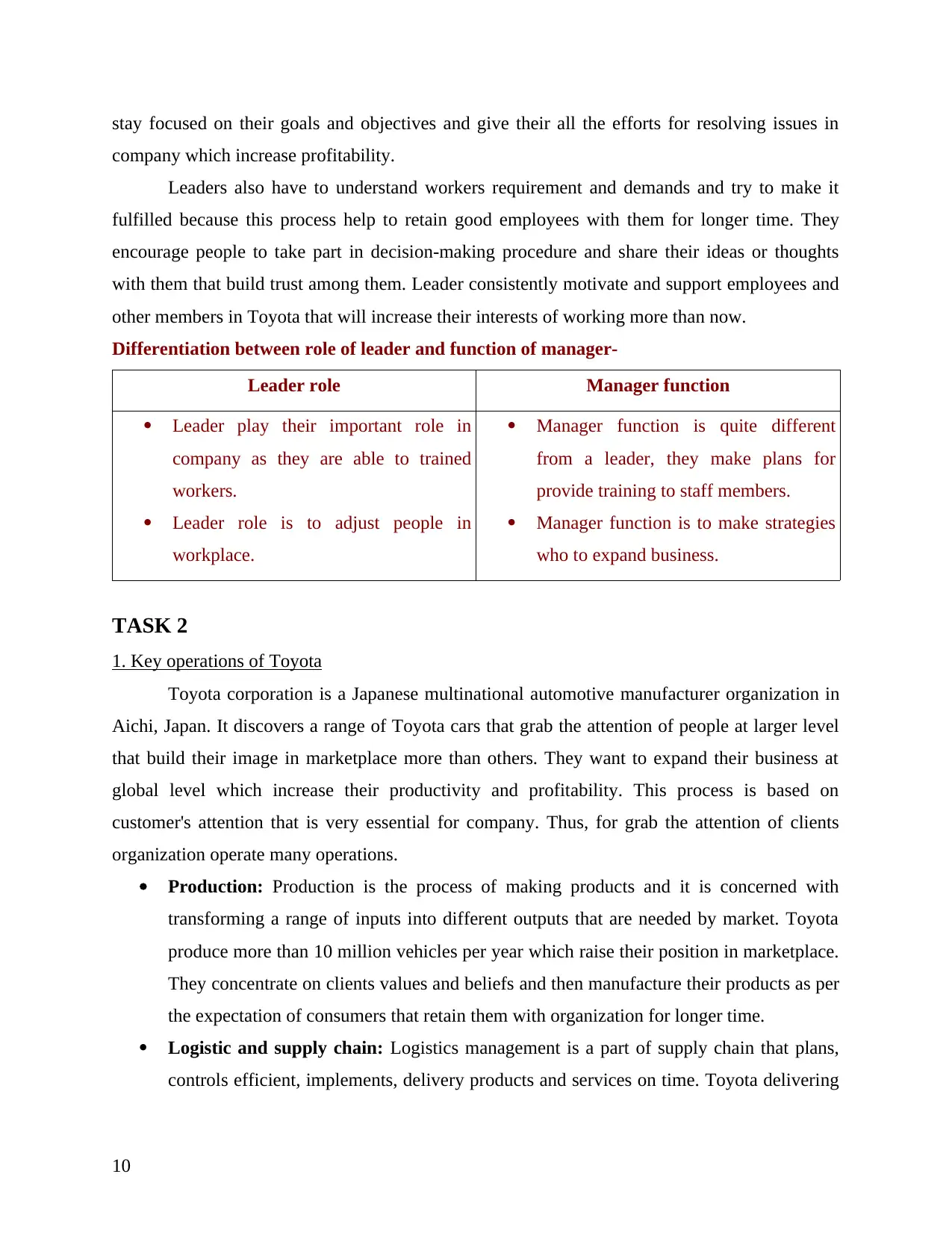
stay focused on their goals and objectives and give their all the efforts for resolving issues in
company which increase profitability.
Leaders also have to understand workers requirement and demands and try to make it
fulfilled because this process help to retain good employees with them for longer time. They
encourage people to take part in decision-making procedure and share their ideas or thoughts
with them that build trust among them. Leader consistently motivate and support employees and
other members in Toyota that will increase their interests of working more than now.
Differentiation between role of leader and function of manager-
Leader role Manager function
Leader play their important role in
company as they are able to trained
workers.
Leader role is to adjust people in
workplace.
Manager function is quite different
from a leader, they make plans for
provide training to staff members.
Manager function is to make strategies
who to expand business.
TASK 2
1. Key operations of Toyota
Toyota corporation is a Japanese multinational automotive manufacturer organization in
Aichi, Japan. It discovers a range of Toyota cars that grab the attention of people at larger level
that build their image in marketplace more than others. They want to expand their business at
global level which increase their productivity and profitability. This process is based on
customer's attention that is very essential for company. Thus, for grab the attention of clients
organization operate many operations.
Production: Production is the process of making products and it is concerned with
transforming a range of inputs into different outputs that are needed by market. Toyota
produce more than 10 million vehicles per year which raise their position in marketplace.
They concentrate on clients values and beliefs and then manufacture their products as per
the expectation of consumers that retain them with organization for longer time.
Logistic and supply chain: Logistics management is a part of supply chain that plans,
controls efficient, implements, delivery products and services on time. Toyota delivering
10
company which increase profitability.
Leaders also have to understand workers requirement and demands and try to make it
fulfilled because this process help to retain good employees with them for longer time. They
encourage people to take part in decision-making procedure and share their ideas or thoughts
with them that build trust among them. Leader consistently motivate and support employees and
other members in Toyota that will increase their interests of working more than now.
Differentiation between role of leader and function of manager-
Leader role Manager function
Leader play their important role in
company as they are able to trained
workers.
Leader role is to adjust people in
workplace.
Manager function is quite different
from a leader, they make plans for
provide training to staff members.
Manager function is to make strategies
who to expand business.
TASK 2
1. Key operations of Toyota
Toyota corporation is a Japanese multinational automotive manufacturer organization in
Aichi, Japan. It discovers a range of Toyota cars that grab the attention of people at larger level
that build their image in marketplace more than others. They want to expand their business at
global level which increase their productivity and profitability. This process is based on
customer's attention that is very essential for company. Thus, for grab the attention of clients
organization operate many operations.
Production: Production is the process of making products and it is concerned with
transforming a range of inputs into different outputs that are needed by market. Toyota
produce more than 10 million vehicles per year which raise their position in marketplace.
They concentrate on clients values and beliefs and then manufacture their products as per
the expectation of consumers that retain them with organization for longer time.
Logistic and supply chain: Logistics management is a part of supply chain that plans,
controls efficient, implements, delivery products and services on time. Toyota delivering
10
Secure Best Marks with AI Grader
Need help grading? Try our AI Grader for instant feedback on your assignments.
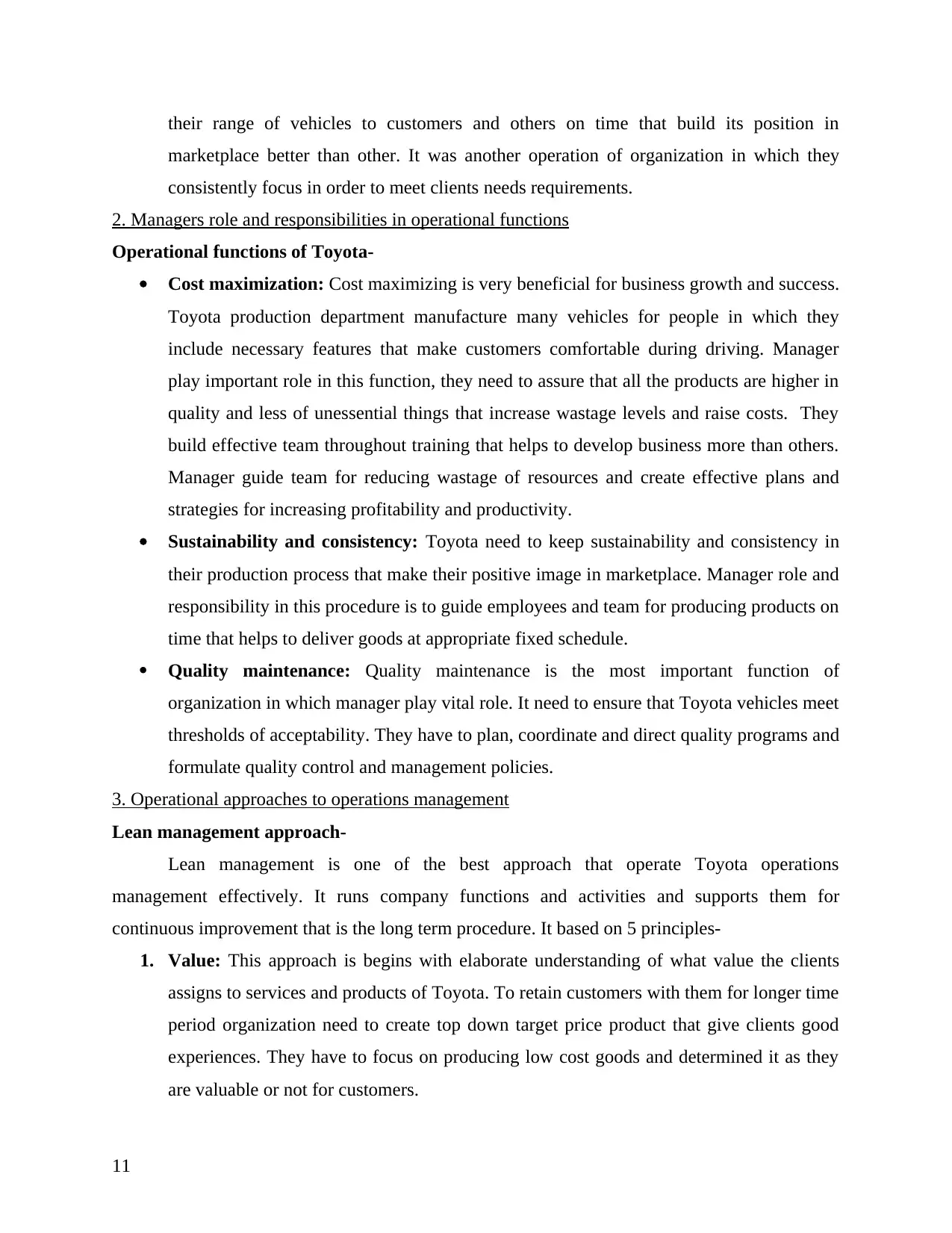
their range of vehicles to customers and others on time that build its position in
marketplace better than other. It was another operation of organization in which they
consistently focus in order to meet clients needs requirements.
2. Managers role and responsibilities in operational functions
Operational functions of Toyota-
Cost maximization: Cost maximizing is very beneficial for business growth and success.
Toyota production department manufacture many vehicles for people in which they
include necessary features that make customers comfortable during driving. Manager
play important role in this function, they need to assure that all the products are higher in
quality and less of unessential things that increase wastage levels and raise costs. They
build effective team throughout training that helps to develop business more than others.
Manager guide team for reducing wastage of resources and create effective plans and
strategies for increasing profitability and productivity.
Sustainability and consistency: Toyota need to keep sustainability and consistency in
their production process that make their positive image in marketplace. Manager role and
responsibility in this procedure is to guide employees and team for producing products on
time that helps to deliver goods at appropriate fixed schedule.
Quality maintenance: Quality maintenance is the most important function of
organization in which manager play vital role. It need to ensure that Toyota vehicles meet
thresholds of acceptability. They have to plan, coordinate and direct quality programs and
formulate quality control and management policies.
3. Operational approaches to operations management
Lean management approach-
Lean management is one of the best approach that operate Toyota operations
management effectively. It runs company functions and activities and supports them for
continuous improvement that is the long term procedure. It based on 5 principles-
1. Value: This approach is begins with elaborate understanding of what value the clients
assigns to services and products of Toyota. To retain customers with them for longer time
period organization need to create top down target price product that give clients good
experiences. They have to focus on producing low cost goods and determined it as they
are valuable or not for customers.
11
marketplace better than other. It was another operation of organization in which they
consistently focus in order to meet clients needs requirements.
2. Managers role and responsibilities in operational functions
Operational functions of Toyota-
Cost maximization: Cost maximizing is very beneficial for business growth and success.
Toyota production department manufacture many vehicles for people in which they
include necessary features that make customers comfortable during driving. Manager
play important role in this function, they need to assure that all the products are higher in
quality and less of unessential things that increase wastage levels and raise costs. They
build effective team throughout training that helps to develop business more than others.
Manager guide team for reducing wastage of resources and create effective plans and
strategies for increasing profitability and productivity.
Sustainability and consistency: Toyota need to keep sustainability and consistency in
their production process that make their positive image in marketplace. Manager role and
responsibility in this procedure is to guide employees and team for producing products on
time that helps to deliver goods at appropriate fixed schedule.
Quality maintenance: Quality maintenance is the most important function of
organization in which manager play vital role. It need to ensure that Toyota vehicles meet
thresholds of acceptability. They have to plan, coordinate and direct quality programs and
formulate quality control and management policies.
3. Operational approaches to operations management
Lean management approach-
Lean management is one of the best approach that operate Toyota operations
management effectively. It runs company functions and activities and supports them for
continuous improvement that is the long term procedure. It based on 5 principles-
1. Value: This approach is begins with elaborate understanding of what value the clients
assigns to services and products of Toyota. To retain customers with them for longer time
period organization need to create top down target price product that give clients good
experiences. They have to focus on producing low cost goods and determined it as they
are valuable or not for customers.
11
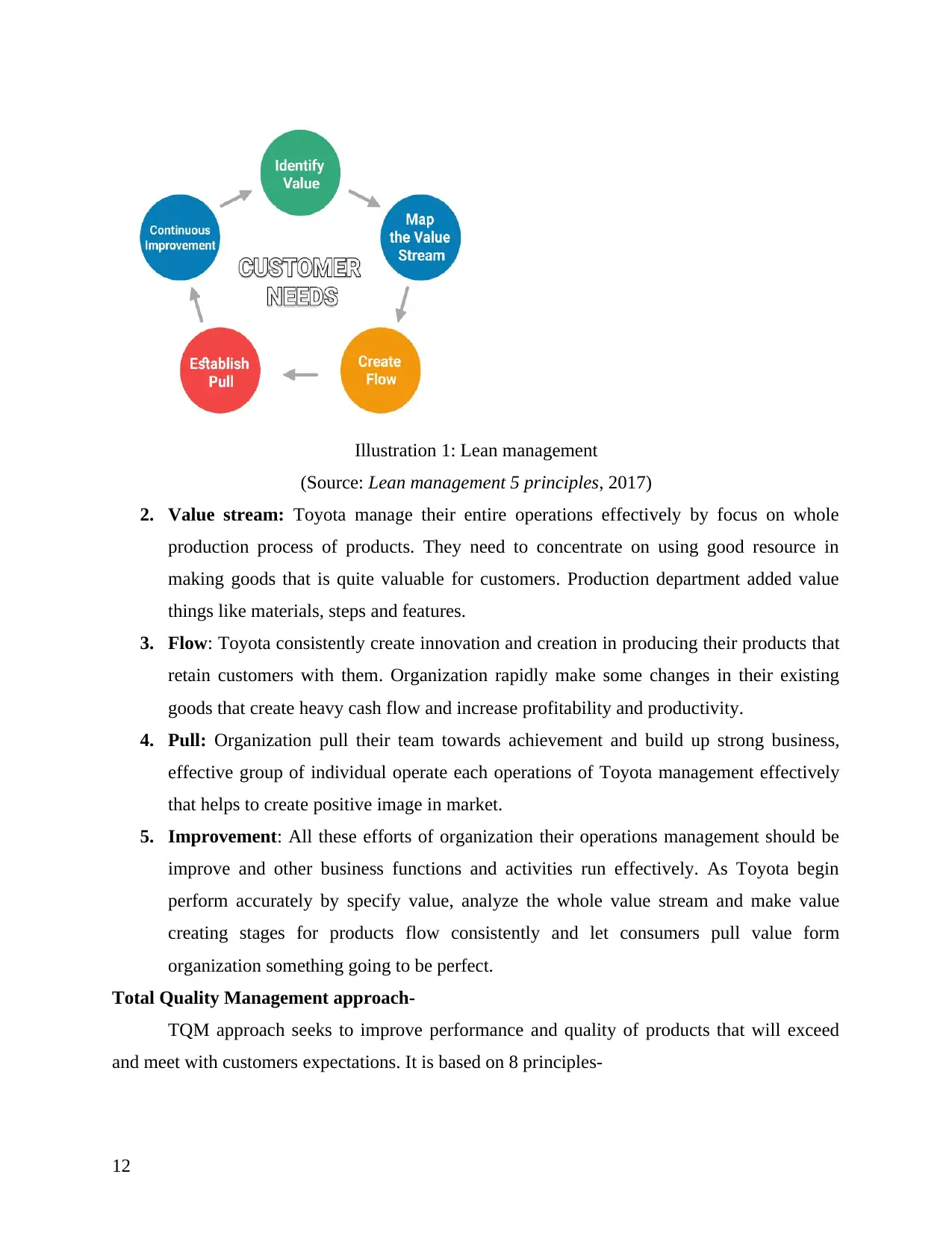
Illustration 1: Lean management
(Source: Lean management 5 principles, 2017)
2. Value stream: Toyota manage their entire operations effectively by focus on whole
production process of products. They need to concentrate on using good resource in
making goods that is quite valuable for customers. Production department added value
things like materials, steps and features.
3. Flow: Toyota consistently create innovation and creation in producing their products that
retain customers with them. Organization rapidly make some changes in their existing
goods that create heavy cash flow and increase profitability and productivity.
4. Pull: Organization pull their team towards achievement and build up strong business,
effective group of individual operate each operations of Toyota management effectively
that helps to create positive image in market.
5. Improvement: All these efforts of organization their operations management should be
improve and other business functions and activities run effectively. As Toyota begin
perform accurately by specify value, analyze the whole value stream and make value
creating stages for products flow consistently and let consumers pull value form
organization something going to be perfect.
Total Quality Management approach-
TQM approach seeks to improve performance and quality of products that will exceed
and meet with customers expectations. It is based on 8 principles-
12
(Source: Lean management 5 principles, 2017)
2. Value stream: Toyota manage their entire operations effectively by focus on whole
production process of products. They need to concentrate on using good resource in
making goods that is quite valuable for customers. Production department added value
things like materials, steps and features.
3. Flow: Toyota consistently create innovation and creation in producing their products that
retain customers with them. Organization rapidly make some changes in their existing
goods that create heavy cash flow and increase profitability and productivity.
4. Pull: Organization pull their team towards achievement and build up strong business,
effective group of individual operate each operations of Toyota management effectively
that helps to create positive image in market.
5. Improvement: All these efforts of organization their operations management should be
improve and other business functions and activities run effectively. As Toyota begin
perform accurately by specify value, analyze the whole value stream and make value
creating stages for products flow consistently and let consumers pull value form
organization something going to be perfect.
Total Quality Management approach-
TQM approach seeks to improve performance and quality of products that will exceed
and meet with customers expectations. It is based on 8 principles-
12
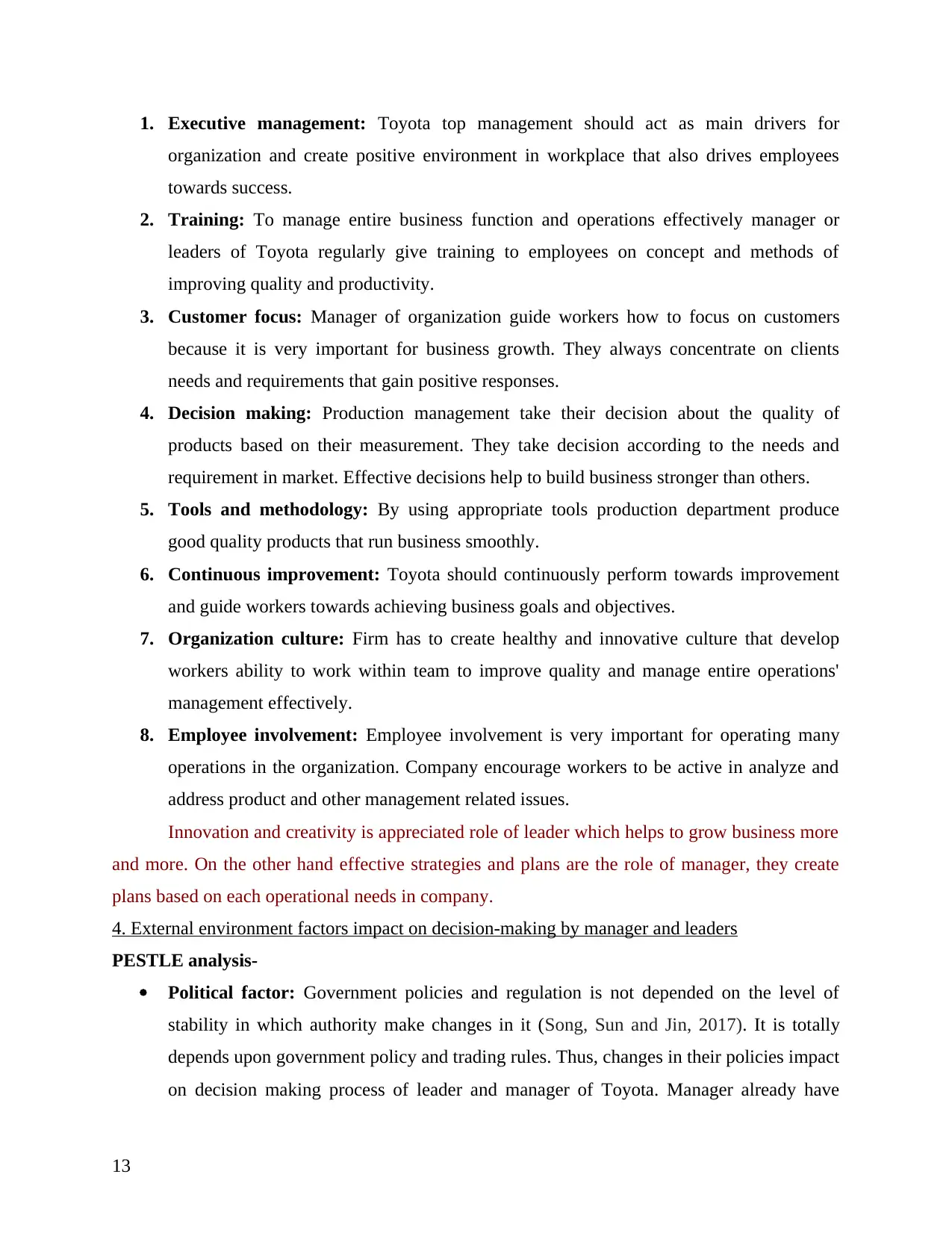
1. Executive management: Toyota top management should act as main drivers for
organization and create positive environment in workplace that also drives employees
towards success.
2. Training: To manage entire business function and operations effectively manager or
leaders of Toyota regularly give training to employees on concept and methods of
improving quality and productivity.
3. Customer focus: Manager of organization guide workers how to focus on customers
because it is very important for business growth. They always concentrate on clients
needs and requirements that gain positive responses.
4. Decision making: Production management take their decision about the quality of
products based on their measurement. They take decision according to the needs and
requirement in market. Effective decisions help to build business stronger than others.
5. Tools and methodology: By using appropriate tools production department produce
good quality products that run business smoothly.
6. Continuous improvement: Toyota should continuously perform towards improvement
and guide workers towards achieving business goals and objectives.
7. Organization culture: Firm has to create healthy and innovative culture that develop
workers ability to work within team to improve quality and manage entire operations'
management effectively.
8. Employee involvement: Employee involvement is very important for operating many
operations in the organization. Company encourage workers to be active in analyze and
address product and other management related issues.
Innovation and creativity is appreciated role of leader which helps to grow business more
and more. On the other hand effective strategies and plans are the role of manager, they create
plans based on each operational needs in company.
4. External environment factors impact on decision-making by manager and leaders
PESTLE analysis-
Political factor: Government policies and regulation is not depended on the level of
stability in which authority make changes in it (Song, Sun and Jin, 2017). It is totally
depends upon government policy and trading rules. Thus, changes in their policies impact
on decision making process of leader and manager of Toyota. Manager already have
13
organization and create positive environment in workplace that also drives employees
towards success.
2. Training: To manage entire business function and operations effectively manager or
leaders of Toyota regularly give training to employees on concept and methods of
improving quality and productivity.
3. Customer focus: Manager of organization guide workers how to focus on customers
because it is very important for business growth. They always concentrate on clients
needs and requirements that gain positive responses.
4. Decision making: Production management take their decision about the quality of
products based on their measurement. They take decision according to the needs and
requirement in market. Effective decisions help to build business stronger than others.
5. Tools and methodology: By using appropriate tools production department produce
good quality products that run business smoothly.
6. Continuous improvement: Toyota should continuously perform towards improvement
and guide workers towards achieving business goals and objectives.
7. Organization culture: Firm has to create healthy and innovative culture that develop
workers ability to work within team to improve quality and manage entire operations'
management effectively.
8. Employee involvement: Employee involvement is very important for operating many
operations in the organization. Company encourage workers to be active in analyze and
address product and other management related issues.
Innovation and creativity is appreciated role of leader which helps to grow business more
and more. On the other hand effective strategies and plans are the role of manager, they create
plans based on each operational needs in company.
4. External environment factors impact on decision-making by manager and leaders
PESTLE analysis-
Political factor: Government policies and regulation is not depended on the level of
stability in which authority make changes in it (Song, Sun and Jin, 2017). It is totally
depends upon government policy and trading rules. Thus, changes in their policies impact
on decision making process of leader and manager of Toyota. Manager already have
13
Paraphrase This Document
Need a fresh take? Get an instant paraphrase of this document with our AI Paraphraser
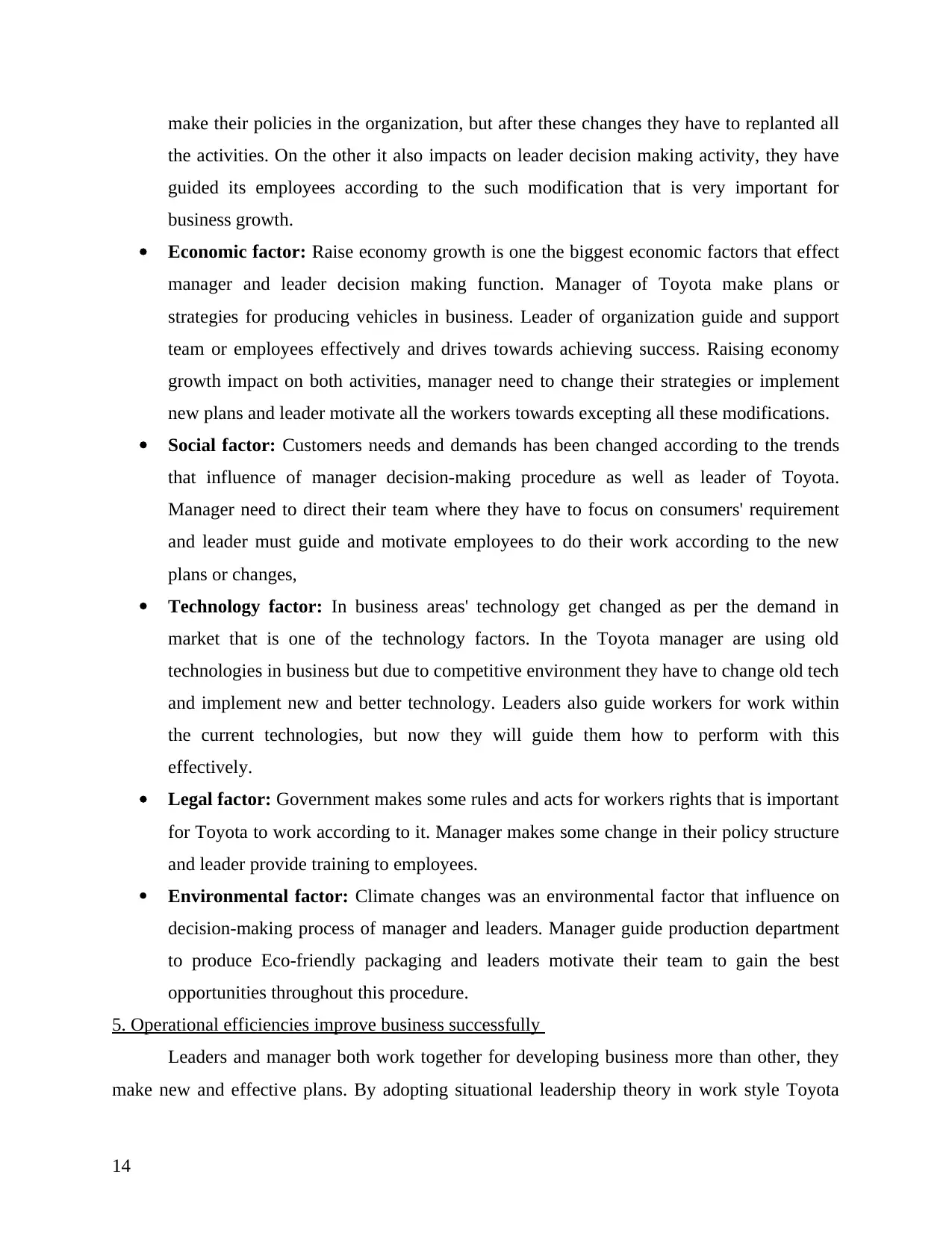
make their policies in the organization, but after these changes they have to replanted all
the activities. On the other it also impacts on leader decision making activity, they have
guided its employees according to the such modification that is very important for
business growth.
Economic factor: Raise economy growth is one the biggest economic factors that effect
manager and leader decision making function. Manager of Toyota make plans or
strategies for producing vehicles in business. Leader of organization guide and support
team or employees effectively and drives towards achieving success. Raising economy
growth impact on both activities, manager need to change their strategies or implement
new plans and leader motivate all the workers towards excepting all these modifications.
Social factor: Customers needs and demands has been changed according to the trends
that influence of manager decision-making procedure as well as leader of Toyota.
Manager need to direct their team where they have to focus on consumers' requirement
and leader must guide and motivate employees to do their work according to the new
plans or changes,
Technology factor: In business areas' technology get changed as per the demand in
market that is one of the technology factors. In the Toyota manager are using old
technologies in business but due to competitive environment they have to change old tech
and implement new and better technology. Leaders also guide workers for work within
the current technologies, but now they will guide them how to perform with this
effectively.
Legal factor: Government makes some rules and acts for workers rights that is important
for Toyota to work according to it. Manager makes some change in their policy structure
and leader provide training to employees.
Environmental factor: Climate changes was an environmental factor that influence on
decision-making process of manager and leaders. Manager guide production department
to produce Eco-friendly packaging and leaders motivate their team to gain the best
opportunities throughout this procedure.
5. Operational efficiencies improve business successfully
Leaders and manager both work together for developing business more than other, they
make new and effective plans. By adopting situational leadership theory in work style Toyota
14
the activities. On the other it also impacts on leader decision making activity, they have
guided its employees according to the such modification that is very important for
business growth.
Economic factor: Raise economy growth is one the biggest economic factors that effect
manager and leader decision making function. Manager of Toyota make plans or
strategies for producing vehicles in business. Leader of organization guide and support
team or employees effectively and drives towards achieving success. Raising economy
growth impact on both activities, manager need to change their strategies or implement
new plans and leader motivate all the workers towards excepting all these modifications.
Social factor: Customers needs and demands has been changed according to the trends
that influence of manager decision-making procedure as well as leader of Toyota.
Manager need to direct their team where they have to focus on consumers' requirement
and leader must guide and motivate employees to do their work according to the new
plans or changes,
Technology factor: In business areas' technology get changed as per the demand in
market that is one of the technology factors. In the Toyota manager are using old
technologies in business but due to competitive environment they have to change old tech
and implement new and better technology. Leaders also guide workers for work within
the current technologies, but now they will guide them how to perform with this
effectively.
Legal factor: Government makes some rules and acts for workers rights that is important
for Toyota to work according to it. Manager makes some change in their policy structure
and leader provide training to employees.
Environmental factor: Climate changes was an environmental factor that influence on
decision-making process of manager and leaders. Manager guide production department
to produce Eco-friendly packaging and leaders motivate their team to gain the best
opportunities throughout this procedure.
5. Operational efficiencies improve business successfully
Leaders and manager both work together for developing business more than other, they
make new and effective plans. By adopting situational leadership theory in work style Toyota
14
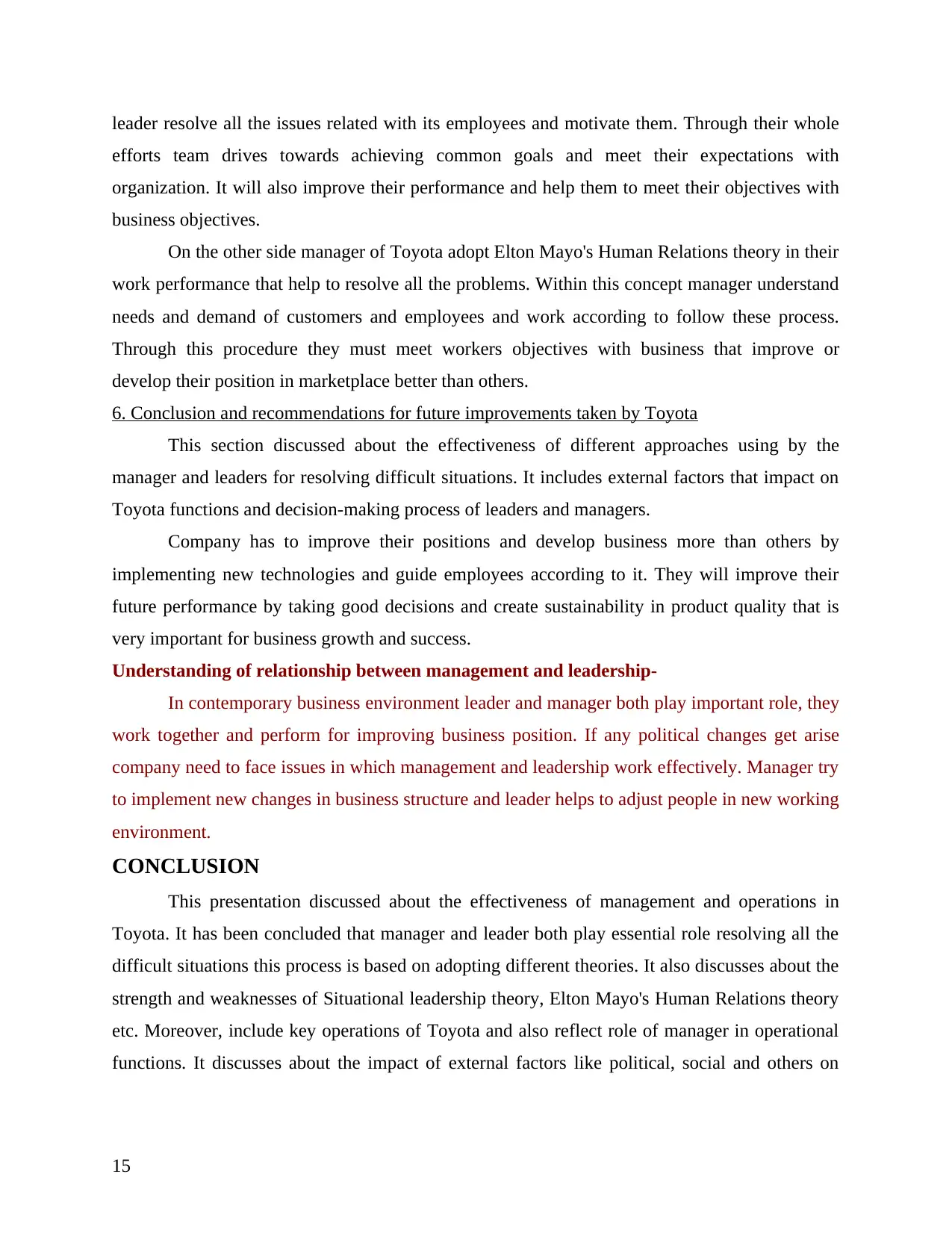
leader resolve all the issues related with its employees and motivate them. Through their whole
efforts team drives towards achieving common goals and meet their expectations with
organization. It will also improve their performance and help them to meet their objectives with
business objectives.
On the other side manager of Toyota adopt Elton Mayo's Human Relations theory in their
work performance that help to resolve all the problems. Within this concept manager understand
needs and demand of customers and employees and work according to follow these process.
Through this procedure they must meet workers objectives with business that improve or
develop their position in marketplace better than others.
6. Conclusion and recommendations for future improvements taken by Toyota
This section discussed about the effectiveness of different approaches using by the
manager and leaders for resolving difficult situations. It includes external factors that impact on
Toyota functions and decision-making process of leaders and managers.
Company has to improve their positions and develop business more than others by
implementing new technologies and guide employees according to it. They will improve their
future performance by taking good decisions and create sustainability in product quality that is
very important for business growth and success.
Understanding of relationship between management and leadership-
In contemporary business environment leader and manager both play important role, they
work together and perform for improving business position. If any political changes get arise
company need to face issues in which management and leadership work effectively. Manager try
to implement new changes in business structure and leader helps to adjust people in new working
environment.
CONCLUSION
This presentation discussed about the effectiveness of management and operations in
Toyota. It has been concluded that manager and leader both play essential role resolving all the
difficult situations this process is based on adopting different theories. It also discusses about the
strength and weaknesses of Situational leadership theory, Elton Mayo's Human Relations theory
etc. Moreover, include key operations of Toyota and also reflect role of manager in operational
functions. It discusses about the impact of external factors like political, social and others on
15
efforts team drives towards achieving common goals and meet their expectations with
organization. It will also improve their performance and help them to meet their objectives with
business objectives.
On the other side manager of Toyota adopt Elton Mayo's Human Relations theory in their
work performance that help to resolve all the problems. Within this concept manager understand
needs and demand of customers and employees and work according to follow these process.
Through this procedure they must meet workers objectives with business that improve or
develop their position in marketplace better than others.
6. Conclusion and recommendations for future improvements taken by Toyota
This section discussed about the effectiveness of different approaches using by the
manager and leaders for resolving difficult situations. It includes external factors that impact on
Toyota functions and decision-making process of leaders and managers.
Company has to improve their positions and develop business more than others by
implementing new technologies and guide employees according to it. They will improve their
future performance by taking good decisions and create sustainability in product quality that is
very important for business growth and success.
Understanding of relationship between management and leadership-
In contemporary business environment leader and manager both play important role, they
work together and perform for improving business position. If any political changes get arise
company need to face issues in which management and leadership work effectively. Manager try
to implement new changes in business structure and leader helps to adjust people in new working
environment.
CONCLUSION
This presentation discussed about the effectiveness of management and operations in
Toyota. It has been concluded that manager and leader both play essential role resolving all the
difficult situations this process is based on adopting different theories. It also discusses about the
strength and weaknesses of Situational leadership theory, Elton Mayo's Human Relations theory
etc. Moreover, include key operations of Toyota and also reflect role of manager in operational
functions. It discusses about the impact of external factors like political, social and others on
15
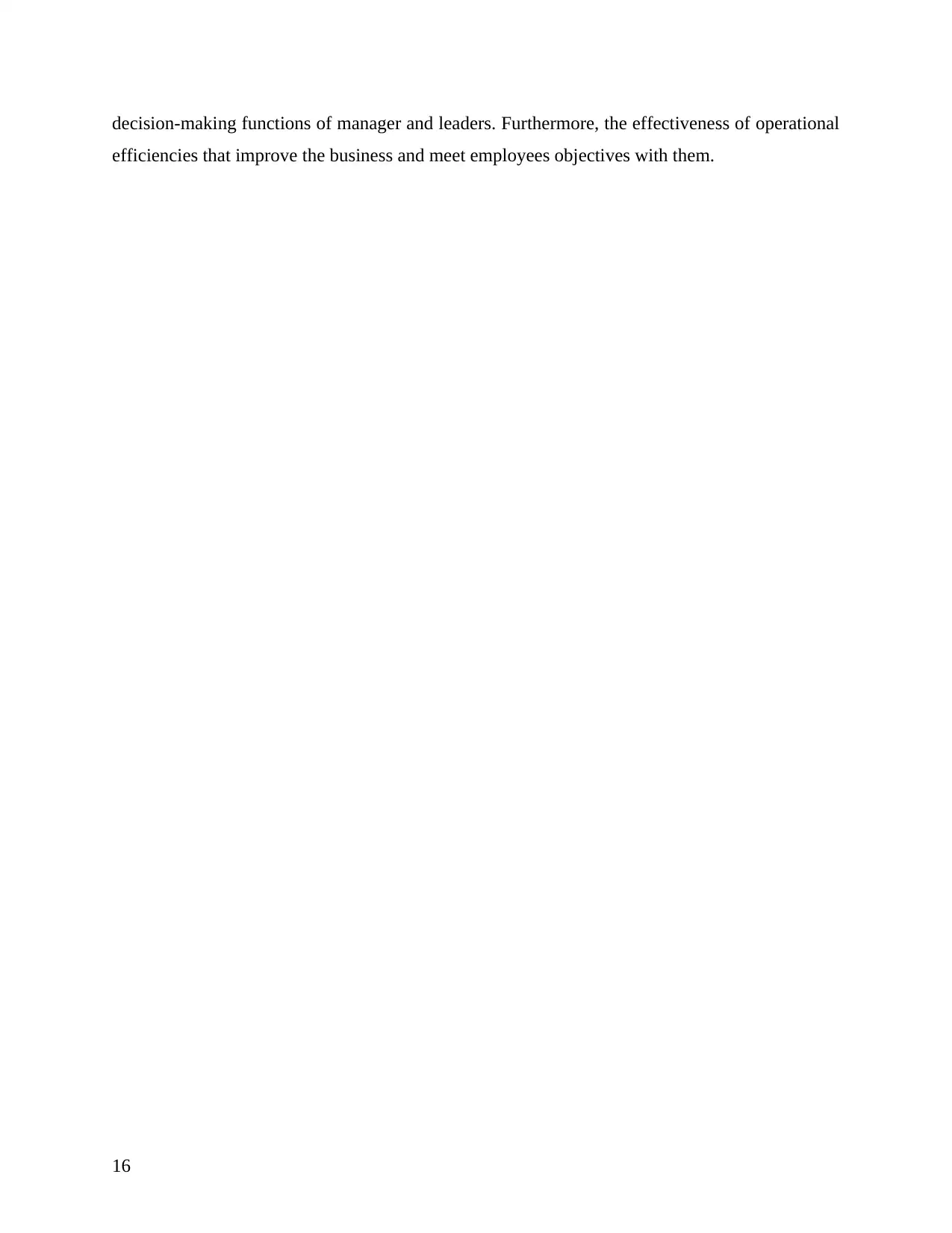
decision-making functions of manager and leaders. Furthermore, the effectiveness of operational
efficiencies that improve the business and meet employees objectives with them.
16
efficiencies that improve the business and meet employees objectives with them.
16
Secure Best Marks with AI Grader
Need help grading? Try our AI Grader for instant feedback on your assignments.
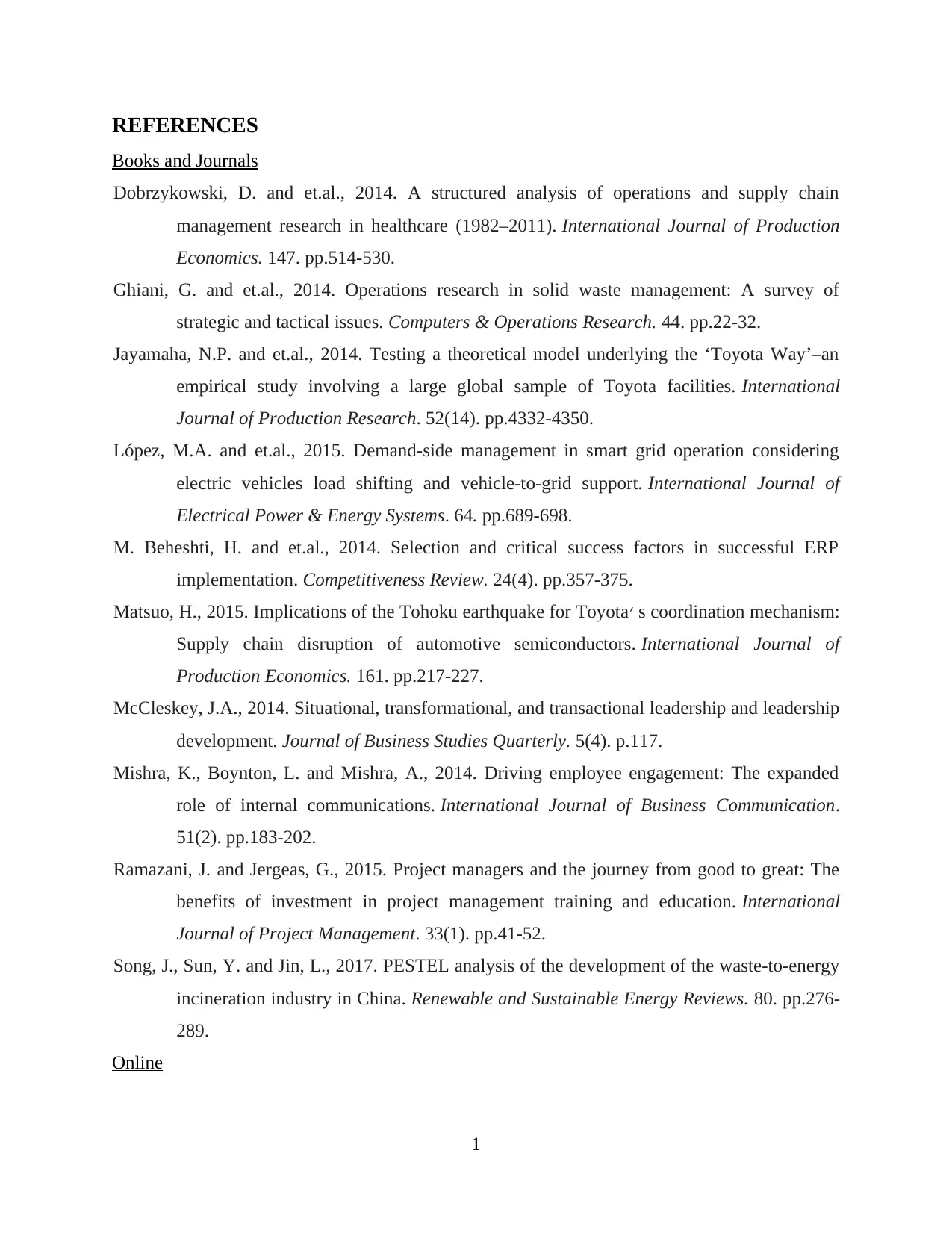
REFERENCES
Books and Journals
Dobrzykowski, D. and et.al., 2014. A structured analysis of operations and supply chain
management research in healthcare (1982–2011). International Journal of Production
Economics. 147. pp.514-530.
Ghiani, G. and et.al., 2014. Operations research in solid waste management: A survey of
strategic and tactical issues. Computers & Operations Research. 44. pp.22-32.
Jayamaha, N.P. and et.al., 2014. Testing a theoretical model underlying the ‘Toyota Way’–an
empirical study involving a large global sample of Toyota facilities. International
Journal of Production Research. 52(14). pp.4332-4350.
López, M.A. and et.al., 2015. Demand-side management in smart grid operation considering
electric vehicles load shifting and vehicle-to-grid support. International Journal of
Electrical Power & Energy Systems. 64. pp.689-698.
M. Beheshti, H. and et.al., 2014. Selection and critical success factors in successful ERP
implementation. Competitiveness Review. 24(4). pp.357-375.
Matsuo, H., 2015. Implications of the Tohoku earthquake for Toyota׳ s coordination mechanism:
Supply chain disruption of automotive semiconductors. International Journal of
Production Economics. 161. pp.217-227.
McCleskey, J.A., 2014. Situational, transformational, and transactional leadership and leadership
development. Journal of Business Studies Quarterly. 5(4). p.117.
Mishra, K., Boynton, L. and Mishra, A., 2014. Driving employee engagement: The expanded
role of internal communications. International Journal of Business Communication.
51(2). pp.183-202.
Ramazani, J. and Jergeas, G., 2015. Project managers and the journey from good to great: The
benefits of investment in project management training and education. International
Journal of Project Management. 33(1). pp.41-52.
Song, J., Sun, Y. and Jin, L., 2017. PESTEL analysis of the development of the waste-to-energy
incineration industry in China. Renewable and Sustainable Energy Reviews. 80. pp.276-
289.
Online
1
Books and Journals
Dobrzykowski, D. and et.al., 2014. A structured analysis of operations and supply chain
management research in healthcare (1982–2011). International Journal of Production
Economics. 147. pp.514-530.
Ghiani, G. and et.al., 2014. Operations research in solid waste management: A survey of
strategic and tactical issues. Computers & Operations Research. 44. pp.22-32.
Jayamaha, N.P. and et.al., 2014. Testing a theoretical model underlying the ‘Toyota Way’–an
empirical study involving a large global sample of Toyota facilities. International
Journal of Production Research. 52(14). pp.4332-4350.
López, M.A. and et.al., 2015. Demand-side management in smart grid operation considering
electric vehicles load shifting and vehicle-to-grid support. International Journal of
Electrical Power & Energy Systems. 64. pp.689-698.
M. Beheshti, H. and et.al., 2014. Selection and critical success factors in successful ERP
implementation. Competitiveness Review. 24(4). pp.357-375.
Matsuo, H., 2015. Implications of the Tohoku earthquake for Toyota׳ s coordination mechanism:
Supply chain disruption of automotive semiconductors. International Journal of
Production Economics. 161. pp.217-227.
McCleskey, J.A., 2014. Situational, transformational, and transactional leadership and leadership
development. Journal of Business Studies Quarterly. 5(4). p.117.
Mishra, K., Boynton, L. and Mishra, A., 2014. Driving employee engagement: The expanded
role of internal communications. International Journal of Business Communication.
51(2). pp.183-202.
Ramazani, J. and Jergeas, G., 2015. Project managers and the journey from good to great: The
benefits of investment in project management training and education. International
Journal of Project Management. 33(1). pp.41-52.
Song, J., Sun, Y. and Jin, L., 2017. PESTEL analysis of the development of the waste-to-energy
incineration industry in China. Renewable and Sustainable Energy Reviews. 80. pp.276-
289.
Online
1
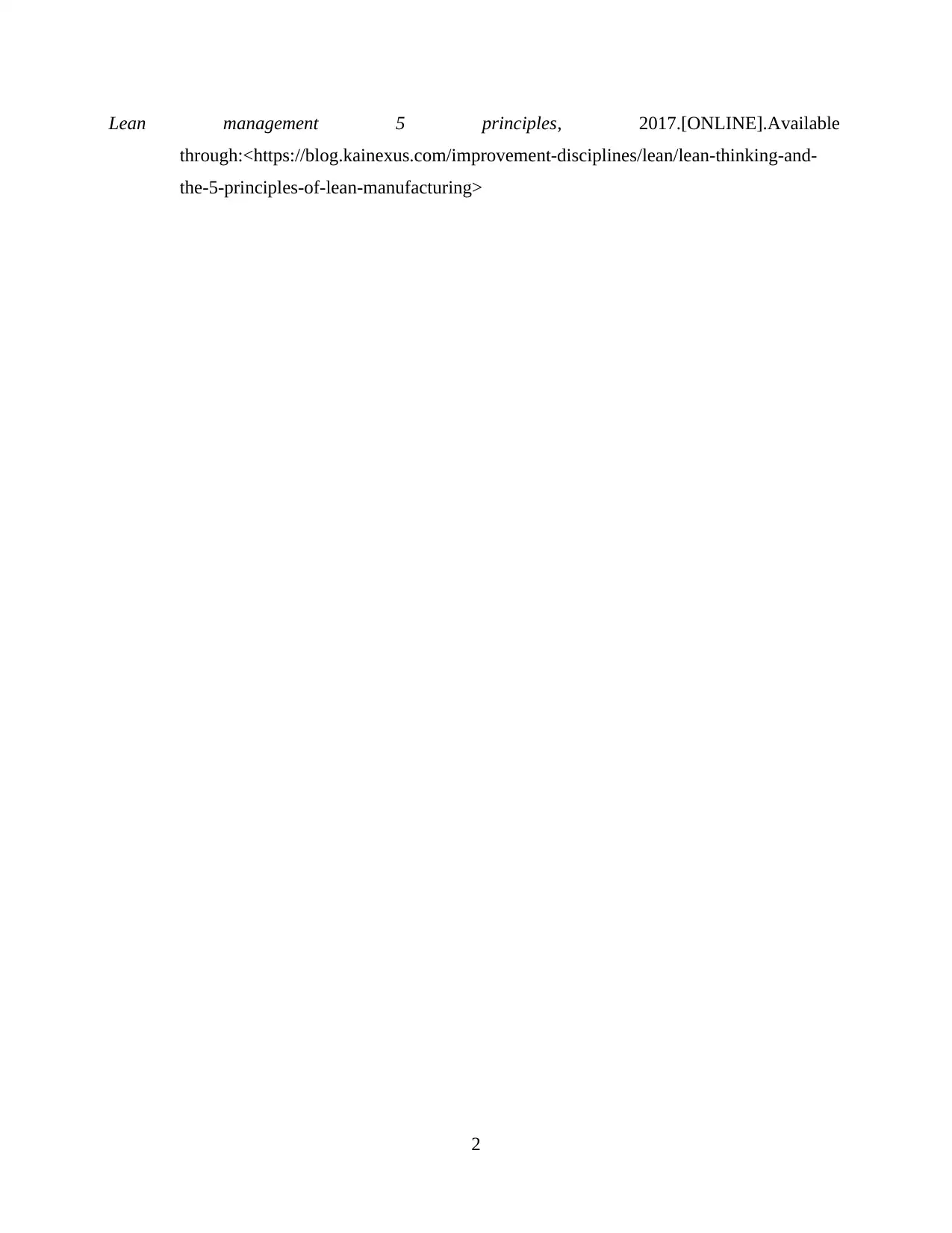
Lean management 5 principles, 2017.[ONLINE].Available
through:<https://blog.kainexus.com/improvement-disciplines/lean/lean-thinking-and-
the-5-principles-of-lean-manufacturing>
2
through:<https://blog.kainexus.com/improvement-disciplines/lean/lean-thinking-and-
the-5-principles-of-lean-manufacturing>
2
1 out of 18
Related Documents
Your All-in-One AI-Powered Toolkit for Academic Success.
+13062052269
info@desklib.com
Available 24*7 on WhatsApp / Email
![[object Object]](/_next/static/media/star-bottom.7253800d.svg)
Unlock your academic potential
© 2024 | Zucol Services PVT LTD | All rights reserved.





